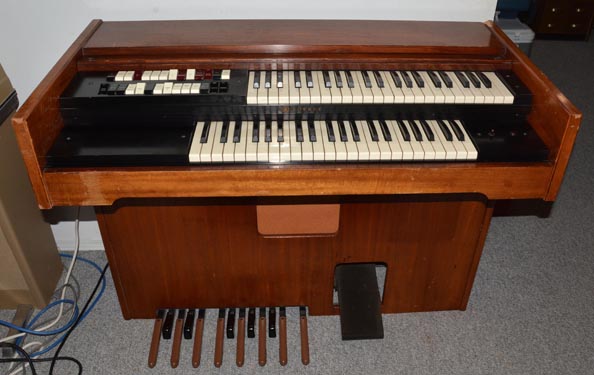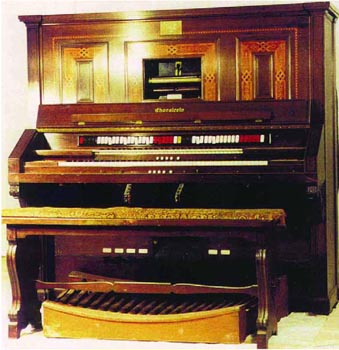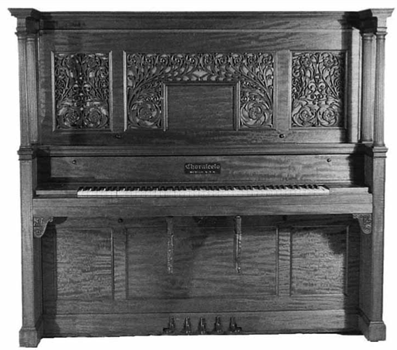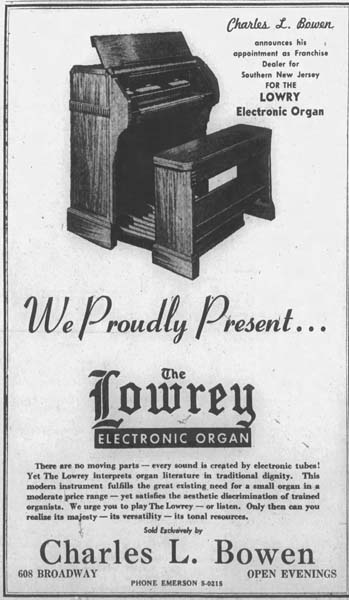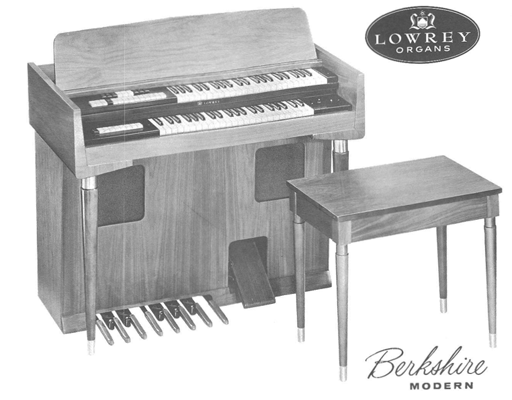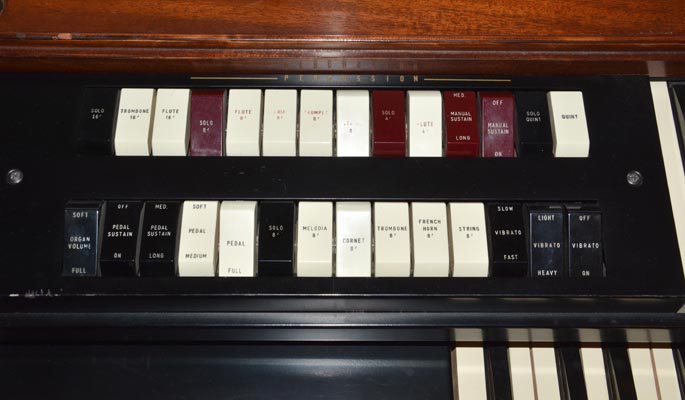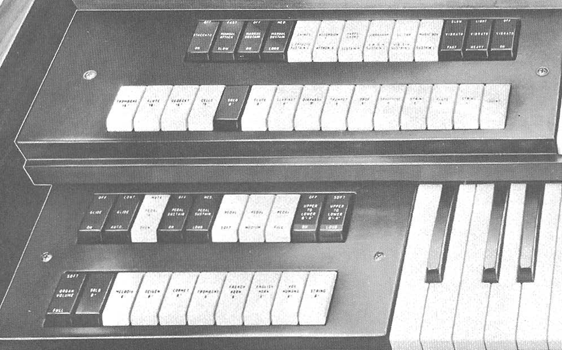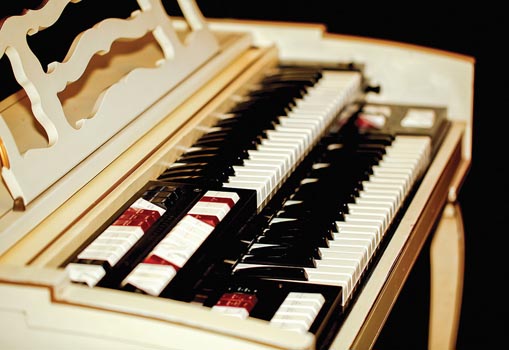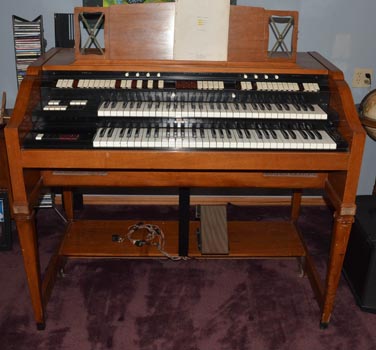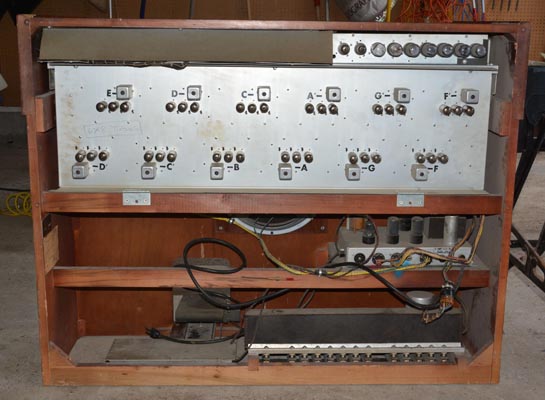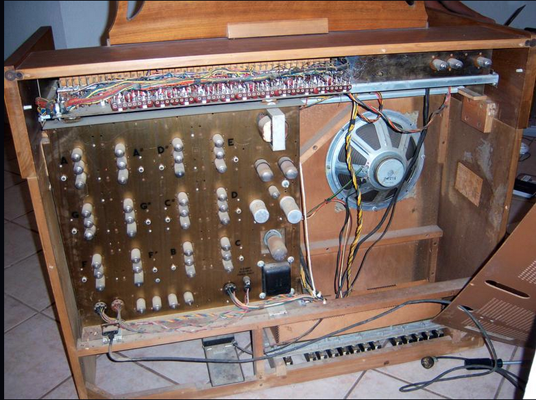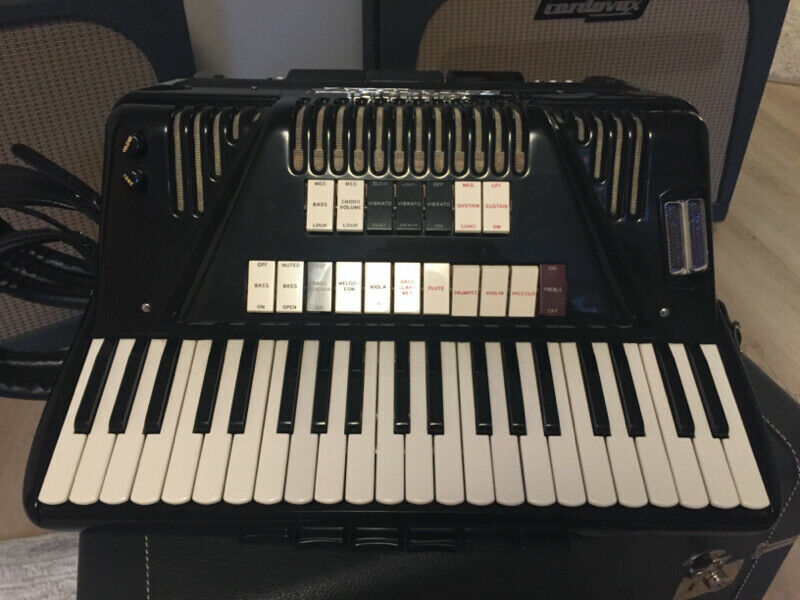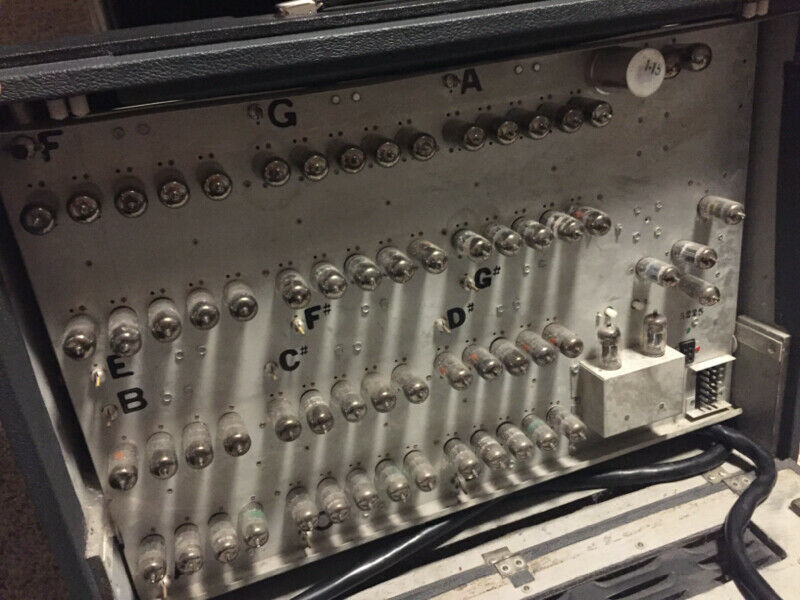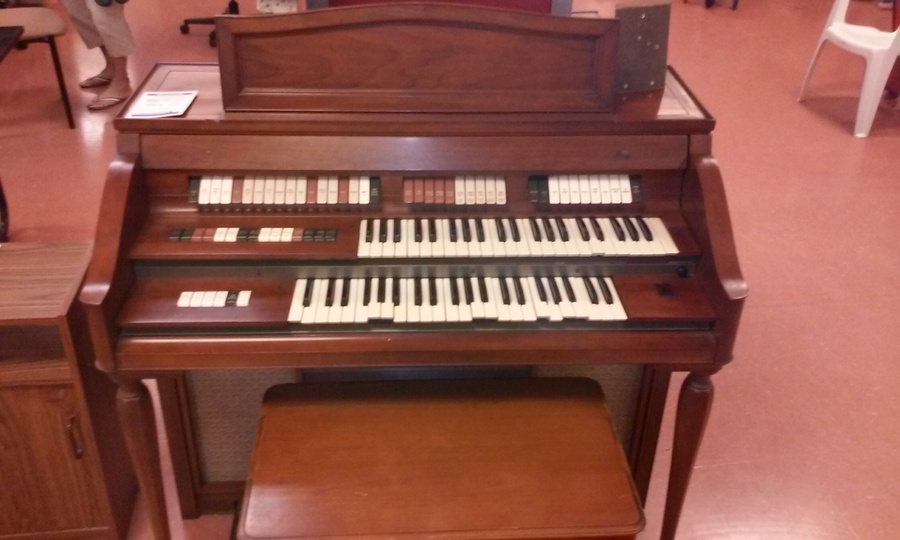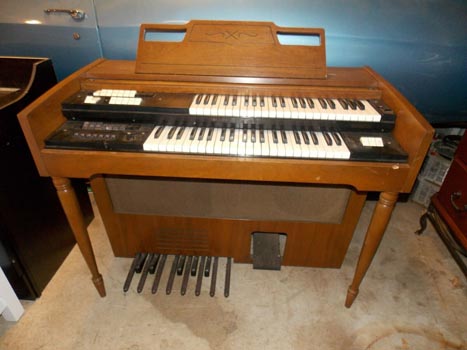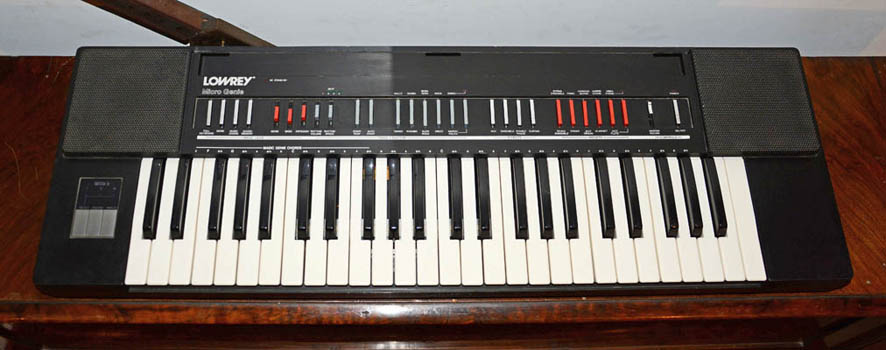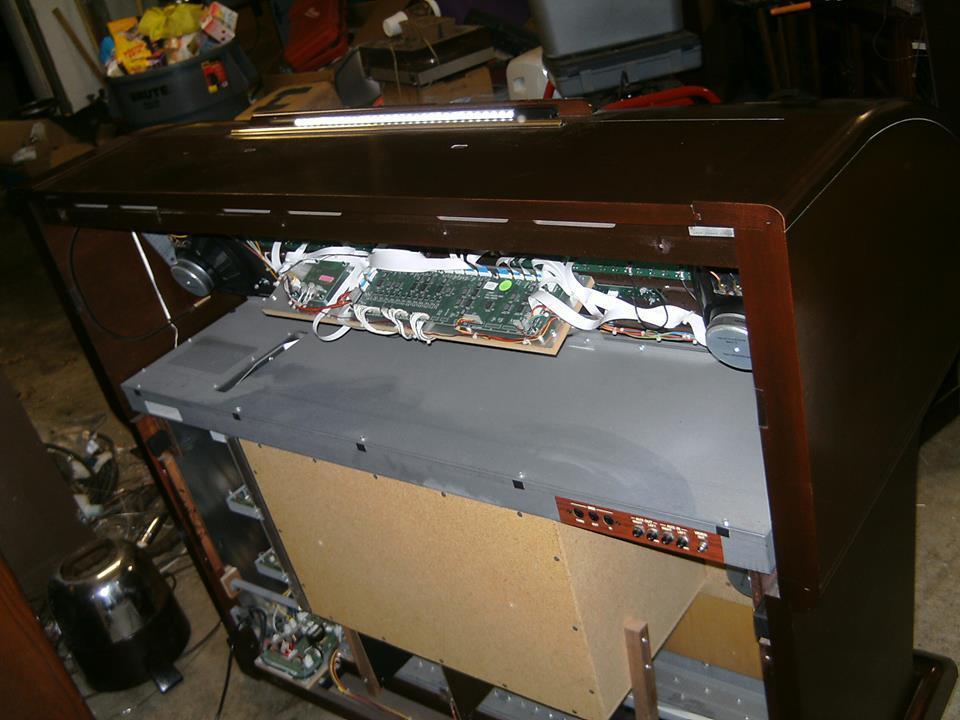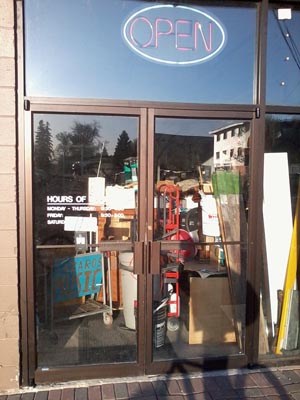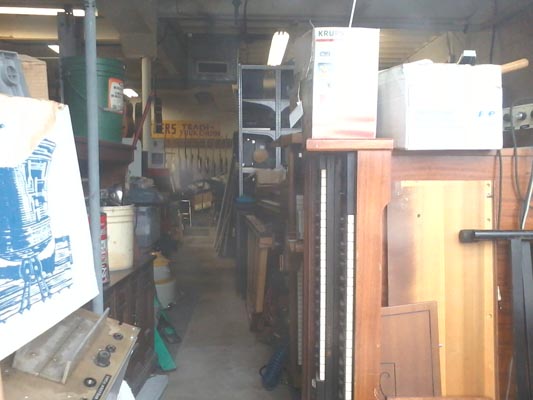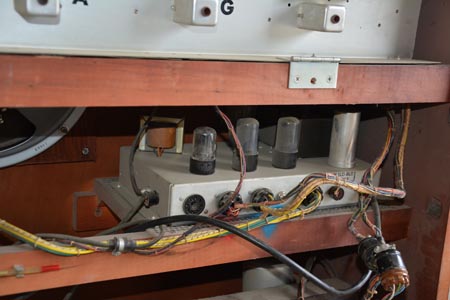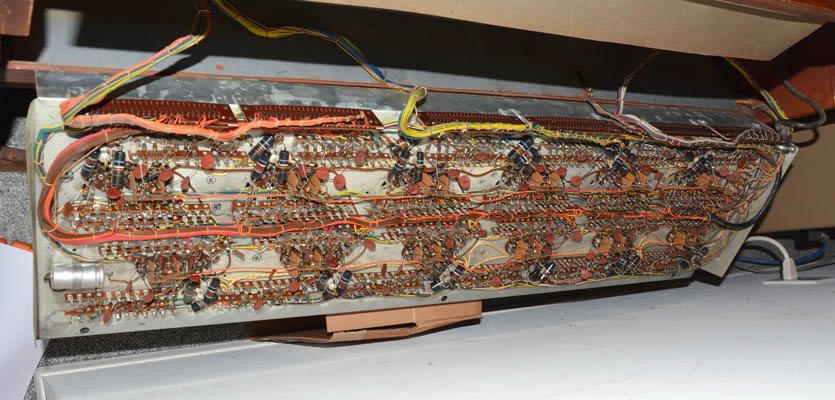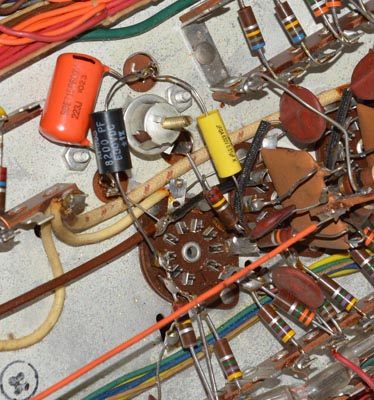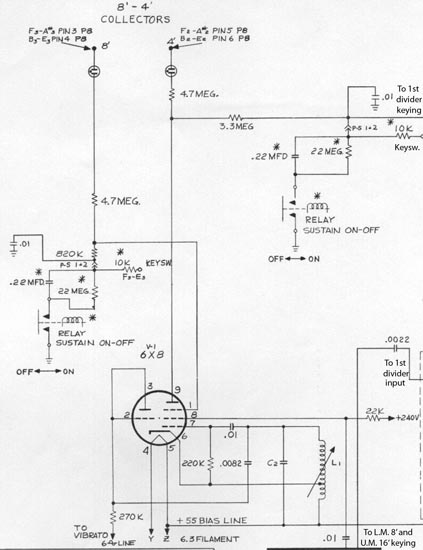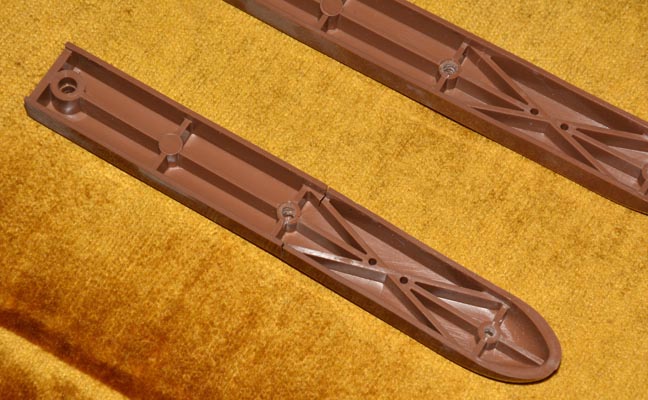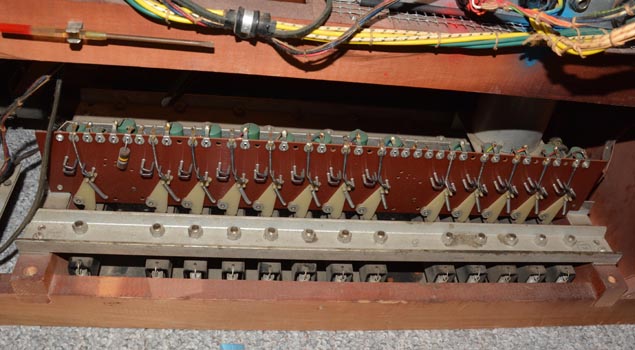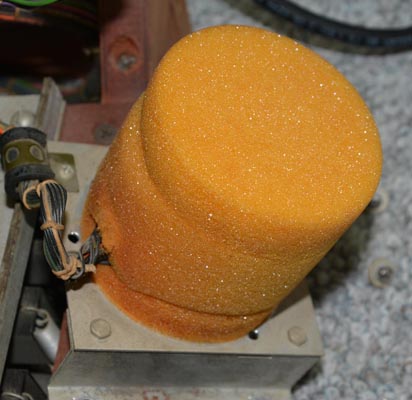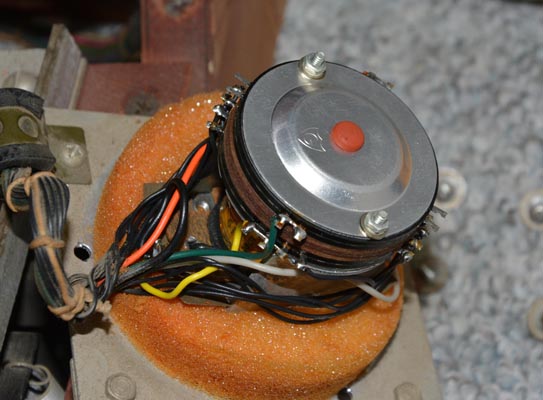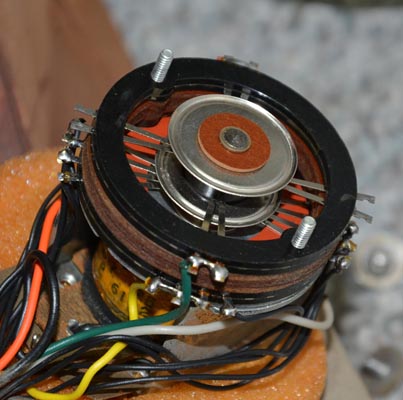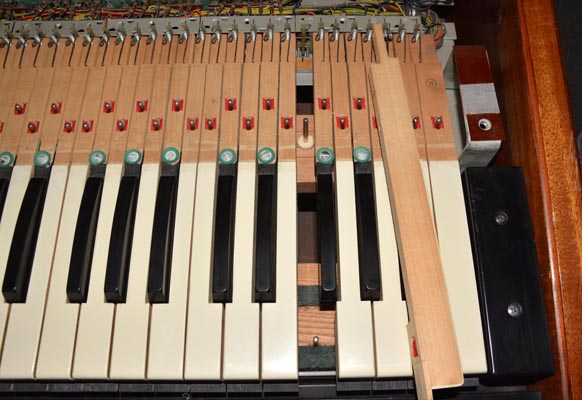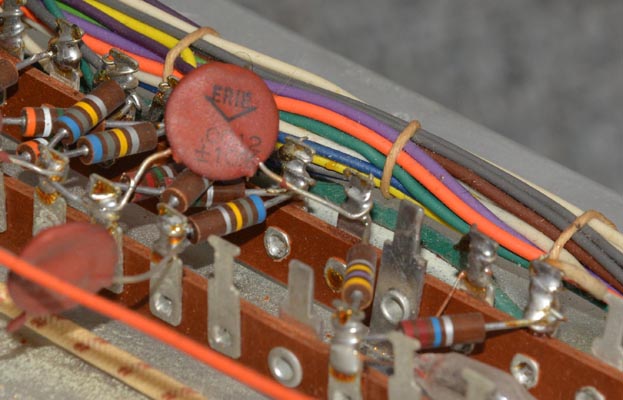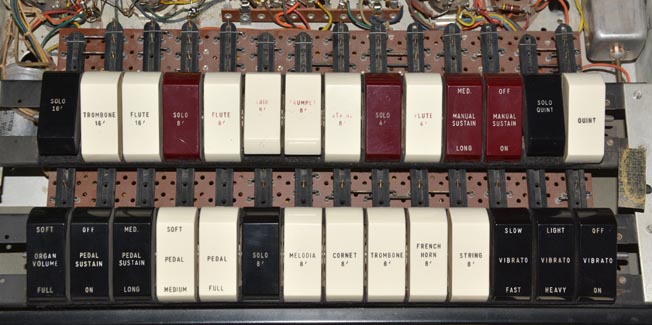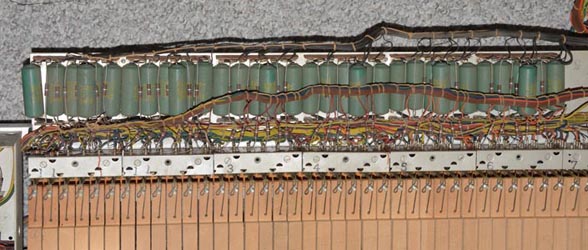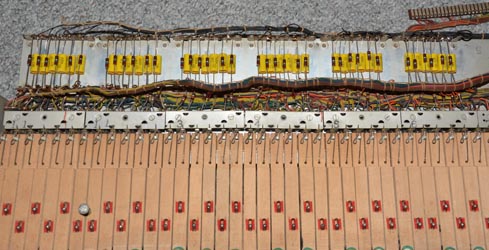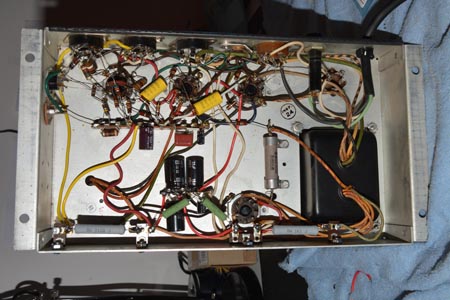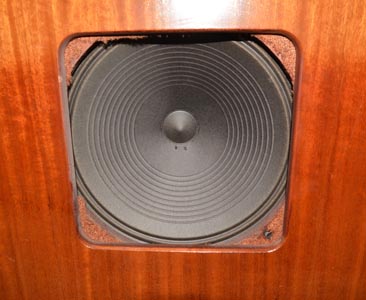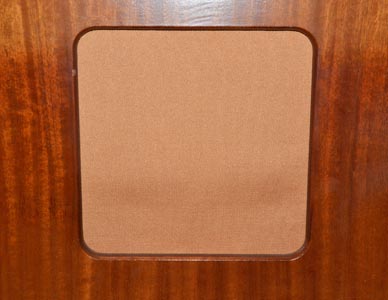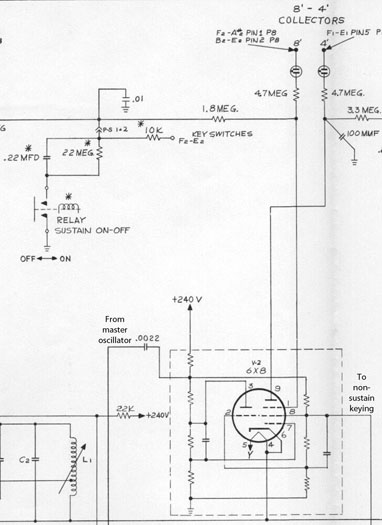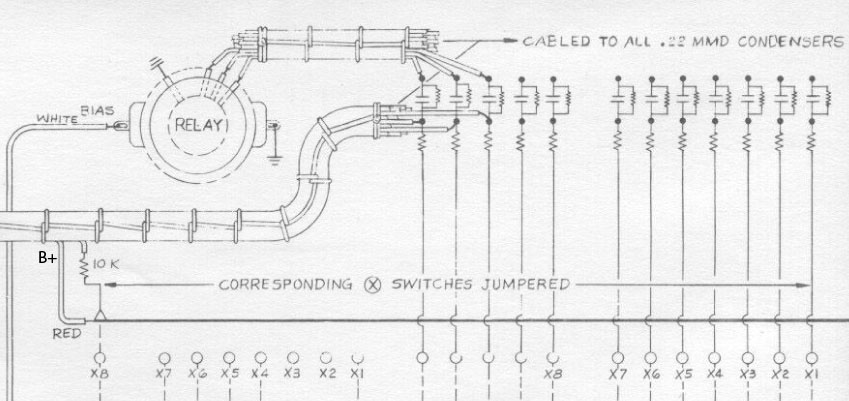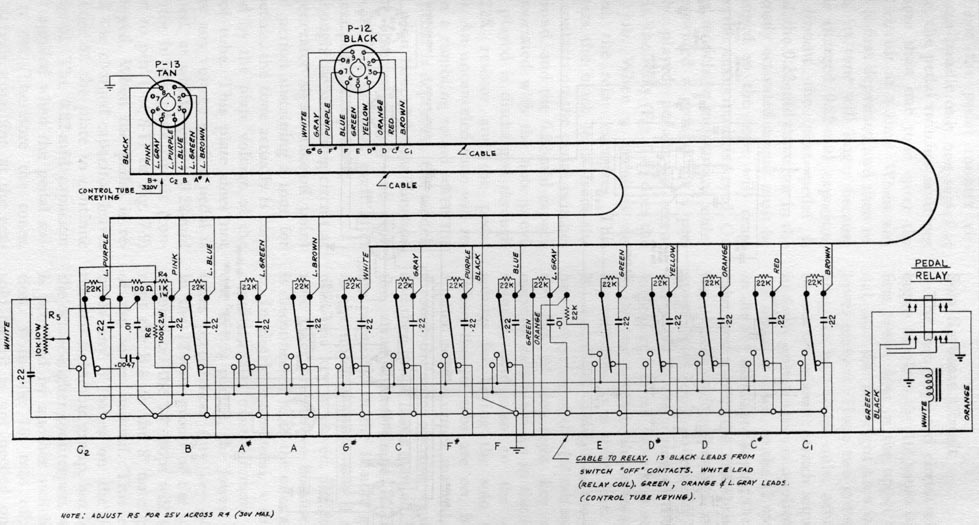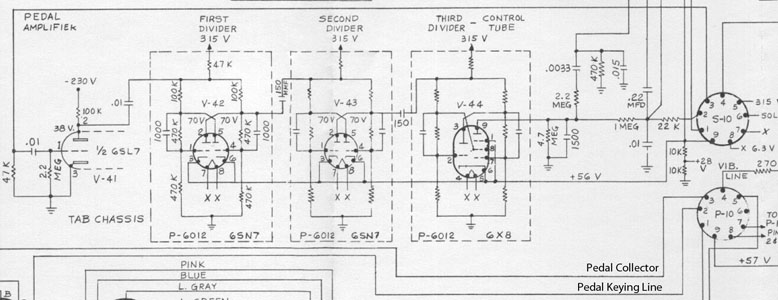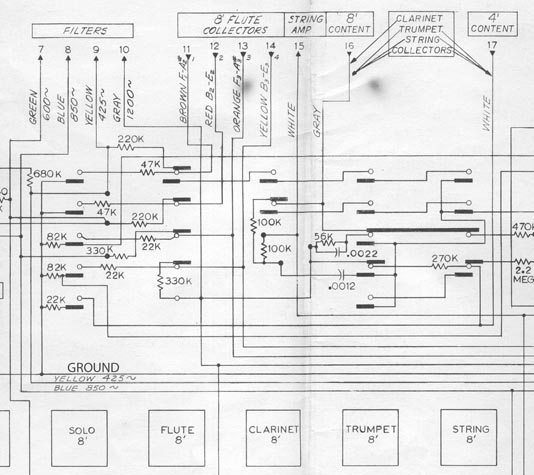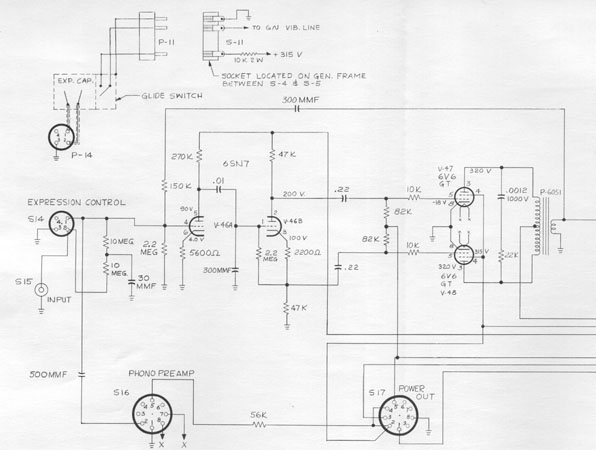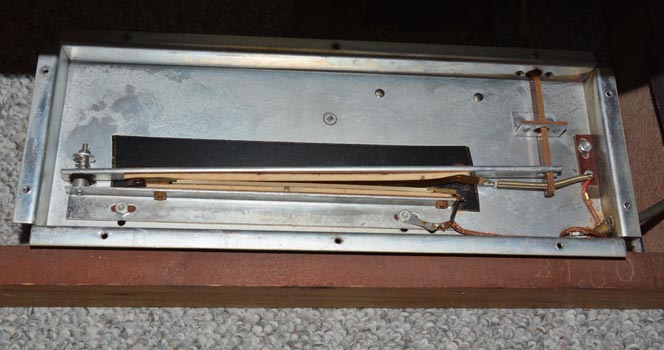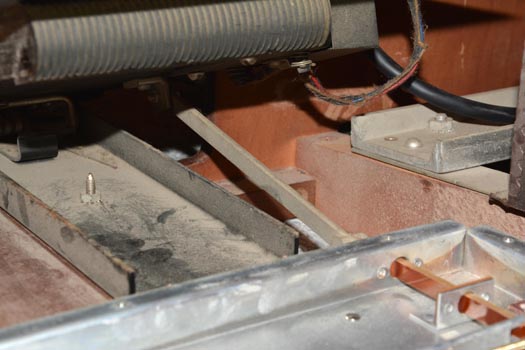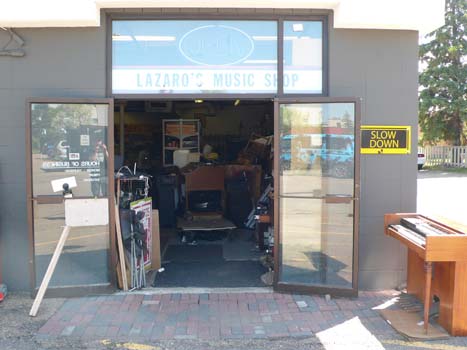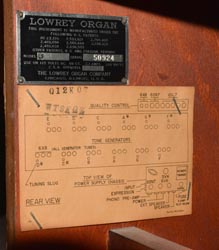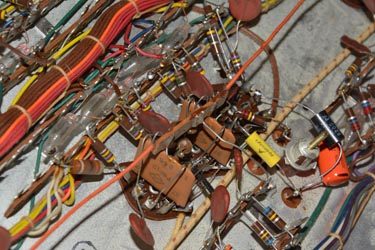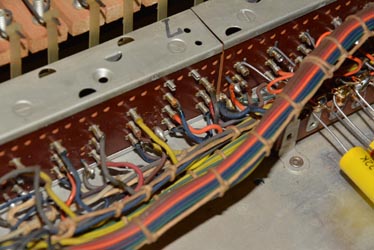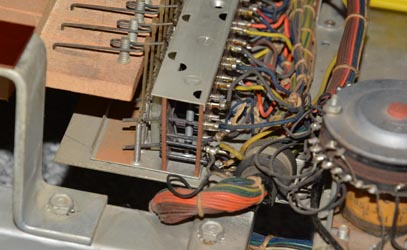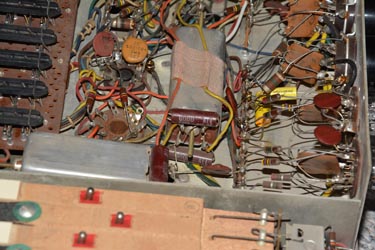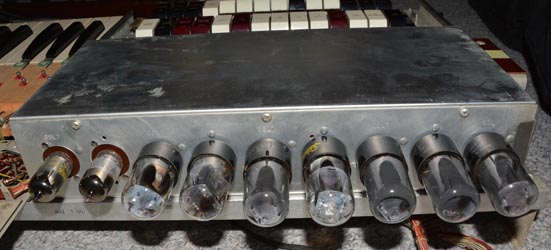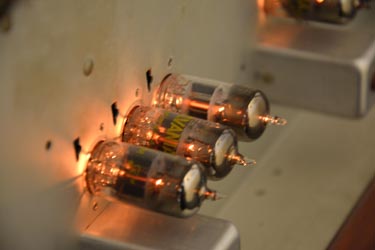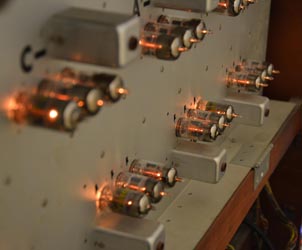Lowrey "Holiday" model LSElectronic Spinet OrganThis article has become much longer and more detailed than originally intended; it has expanded to cover not only the instrument shown above, but also the overall history of the Lowrey Organ Company and products thereof, with emphasis on their tube-based organs made between the mid-'50s and mid-'60s. Following the history lesson, I recount the amusing story of how I acquired my Lowrey LS, and detail the various repairs performed on it. Then comes a long discussion of its electronics, explaining the function of most circuits, some important yet now-obscure ideas that Lowrey based their designs upon, and the merits and demerits of several tube-based designs. Lastly, there is a video demonstrating the sounds. At this point, this article may as well be called "A Treatise on the Lowrey Vacuum-Tube Organ." Whether or not it is worthy of that title, I believe it is the most comprehensive piece on the internet about such things to date. I hope it encourages further renewed interest not only in Lowrey's tube organs, but the entire class of instruments generally. As we already have pipe organs, transistor organs, and digital organs as distinct and not-necessarily-interchangeable categories, so should be tube organs! Introduced in 1957, the LS was the first model in Lowrey's "Holiday" line of relatively small and inexpensive spinet organs. Along with the "Lincolnwood" SS and SST models of the same year, it was the first Lowrey to incorporate sustain, made possible by clever use of neon bulbs and unconventional vacuum tubes. Tone generation is done using a frequency-divider system, producing asymmetric pulsewaves from the master oscillators, and squarewaves from the dividers. Various tricks are used to compensate for an abnormally minimal set of generators, including foldback, frequency division, and—most ingeniously—frequency "doubling". Keyed signals are separated by pitch register and by clavier; the registers having sustain are keyed electronically (in the LS' case, these include the pedalboard 16' and upper-manual 8' and 4'), while the non-sustain registers are directly keyed. Formant filtering—a kind of subtractive synthesis—is used to shape the tones, but with Lowrey's distinctive twist: instead of having separate purpose-built formant circuits for each timbre, a set of shared filter-amplifiers with simple resonant low-pass characteristics are provided. Tones are routed to these filter-amps via rather complex tab switches, sometimes with passive components for additional frequency emphasis. All Lowrey tube organs except the Organo use basically the same generator, keying, and tone-shaping techniques. However, note that the LS and all subsequent "Holidays" implement sustain in a "true" fashion (as do certain others, such as the "Heritage" series), while the SS and SST have "reverb-like" sustain (as does the "Festival", etc.); this difference in sustain behavior is perhaps the most significant point of distinction between Lowrey's tube organs, which are otherwise quite similar in timbre and expression. The combination of several unusual design choices makes for a distinct and recognizable sound. Even in the heyday of tube organs, Lowrey's instruments did not sound quite like any of their contemporaries, and they certainly sound different from anything made today. As well, tube-based Lowrey organs are well-built and easy to repair. Despite being a "low-end" model, the cabinet of the LS is made of thick veneered hardwood, finely crafted and finished. The electronic chassis are plated steel, with some cast metal frames holding the clavier and chassis assemblies. Only a bare minimum of plastics are used, and besides some cracks in the pedal caps (which are the worst part of the LS' design), the plastics have held up well. The wiring is all point-to-point, done by hand. Repairability was clearly considered important by the instrument's designers, given how easy everything is to disassemble and work on; for example, with the removal of only three screws, the massive tone generator chassis hinges down to give full access to its components. The LS is a great example of how manufacturers used to make affordable products without skimping on materials quality nor repairability. In short, the LS model and all other Lowrey tube organs are great-sounding and well-made pieces of history, and are worthy of preservation and continued use. I hope to encourage interest in tube organs with this article, as well as my Lowrey "Festival" FL and Hammond Chord Organ articles, with more to come. I have scanned and uploaded the service manuals for multiple tube organs, including the LS and other "Holidays", as well as entire books on early electronic instruments. These can be found on my Document Scans page. Features
HistoryWith the exception of Hammond, finding historical information about electronic organ manufacturers tends to be difficult. Nonetheless, I have compiled here what I believe to be a reasonable account of the Lowrey Organ Company of Chicago, Illinois, and how the Holiday model LS fits into their history, making use of both online and print sources. I have taken great care in trying to get things right, so if you spot any errors, I would be much obliged to hear about it. My focus is on Lowrey's vacuum-tube instruments, and I make no apology regarding my contempt for their later products—especially those of the 1980s and later—which I believe is justified for musical, technological, and ethical reasons. Let's start with the company's early history. My best source of this information has been Electronic Musical Instruments (3rd edition, 1968) by Richard H. Dorf. A portion of it is copied below: "The company was started by F. C. Lowrey, a mining and oil man and manufacturer of structural materials, who first became interested in home organs as far back as 1918 when he bought the rights to a keyboard instrument called the Choralcello [sic]. Lowrey and James A. Koehl, a patent attorney, sponsored small electronic organ laboratories during the twenties, thirties, and early forties. One of the results was Koehl's ingenious invention of the Lowrey Organo, the company's first really successful musical product, first sold in 1949. [...] In 1955 Lowrey introduced its first successful two-manual organ, a model called the Berkshire. At the time the company was a division of Central Commercial Company [called Central Commercial Industries in earlier editions of the book], whose business was entirely unrelated to musical instruments. In 1955 Lowrey died and in 1956 his son sold the organ rights to Chicago Musical Instruments Company, a large manufacturer of guitars and other instruments. [...] Since the parent company's acquisition of Lowrey in the middle fifties all Lowrey organs had been manufactured by Hallicrafters Company, the well known maker of radio transmitters and receivers. On February 1, 1966, Chicago Musical Instruments purchased the Hallicrafters organ facility, which is now Lowrey Electronics Co., Chicago." The above provides a good outline into which we can insert some interesting details. First to mention is the Choralcelo, a fascinating electromechanical instrument created before the advent of vacuum tubes. These were acoustic instruments except that the vibrating elements were excited by electromagnets, thus without physical contact. Early models used only piano strings, while later ones added ranks of bars and plates of various materials (steel, wood, glass, etc.), their vibrations reinforced by resonant chambers or horns. These supplementary "tone units" could be placed anywhere; one typical location was in a basement underneath the console, with grilles in the floor to pass the sound through. Oscillations for the electromagnets were generated using large rotary interruptors, either cylinder- or disc-based. Through the appropriate interruptors, DC voltage was alternately connected and disconnected from each electromagnet at the resonant frequency of its associated acoustic vibrator. The principle was much like the Telharmonium (or later Hammond tonewheel organ), except that the oscillations produced by the interruptors were only used for excitation, rather than converted to proportional acoustic waves and listened to directly. A simple and clever governor mechanism assured proper speed of the interruptor despite fluctuations in motor speed. The cabinets were especially well-crafted, featuring the sort of intricate and beautiful woodwork often found prior to the mid-to-late 20th century: Despite having piano strings and piano-esque consoles, Choralcelos are probably best classified as electromechanical organs, mainly because they produce sustained tones rather than percussive ones. As well, later and more elaborate instruments had ranks of tone units directly analogous to ranks of pipes, not to mention claviers and combinatory stop tablets typical of organ design. While Choralcelos were clearly superb instruments with qualities that we can only dream of today, they were large and expensive, and thus sold in low quantities to exclusively wealthy clients. Roughly 100 units were made in total, and sadly none are still functional as far as I know. More info can be found here and here (starting at page 204). The sources I have found place very little, if any, emphasis on Frederick C. Lowrey's involvement with the instrument. I suppose it is to be expected, since even if Mr. Lowrey owned rights to the Choralcelo, production never restarted under his ownership after ceasing due to WW1, and the name was never used again. When it comes to Mr. Lowrey's sponsored "electronic organ laboratories", except Mr. Dorf's reference above and some very questionable marketing spin in the Lowrey "Festival" FL owner's manual (which I will not repeat here), I cannot find any info on them. It is possible that some effort was put towards development of the Choralcelo's technology, but regardless, the designs that Lowrey commercialized were fully electronic, thus quite technologically different. Yet, consider that the Choralcelo's basic concept was to combine piano and organ features—basically to make a piano into a kind of organ. Mr. Lowrey was probably inspired by this, given that he recombined the two instruments in a less expensive and elaborate way in the first successful commercial instrument bearing the Lowrey name: the Organo. In earlier versions of this article, I went straight to explaining the Organo at this point, suggesting that it was Lowrey's first musical offering, and that they did not make self-contained organs until 1954 or '55. However, an astute historian discovered newspaper ads showing that self-contained Lowrey organs were indeed offered as early as 1947. Here is an ad found in the October 1, 1948 edition of the Courier-Post from Camden, New Jersey: To reiterate what is shown above, the instrument is simply called the "Lowrey Electronic Organ", considering its tones are generated electronically via vacuum-tube circuits. It sold for a "moderate price", and was clearly intended for churches and other places where "trained organists" reside. It has a traditional cabinet (heavy, tall, and ornate in comparison to later offerings), one full-size manual, and a full-size pedalboard. The 1947 introductory date means that it would've competed with the earliest all-electronic organs from the likes of Baldwin and Conn, which were quite successful. Yet the lack of any online references (to my knowledge) besides a small number of newspaper ads suggests that this early Lowrey was not a commercial success. If any examples survive, I would really like to know. Now, onto the Organo... Introduced in 1949, the Organo's name is a portmanteau of "organ" and "piano", because that is what it involves; it is a 60-key electronic organ attachment for acoustic piano. With the attachment in place, the piano can be played normally, or with supplementary organ sound. By using a felt damper rail, the Organo can be heard on its own. Normally, the connection between piano and Organo is made via a row of 60 keyswitches and a small panel of controls mounted to the piano, while the real workings of the instrument reside within a separate wooden cabinet of roughly 3 x 2 x 1.5 feet. However, some Janssen, Jesse French, Kimball, Mason & Risch, and Story & Clark pianos were made with built-in Organos, such as the attractive Janssen spinet from 1950 shown below (taken from here). These all-in-one instruments have a disadvantage: since the heat of the tubes is contained within the piano cabinet, it can throw off the piano's tuning. However, this is probably not such a problem as some people have made it out to be; I would be interested in comments from real owners of such things. No "pianoless" Organos were ever made, to my knowledge. It is worthwhile describing the design of the Organo briefly in order to compare it to later models. My simplified description is mostly based on the detailed one found in both the 1st and 2nd editions of Richard Dorf's Electronic Musical Instruments, which can be found here. Also, US Patent #RE23,376, filed in 1949, describes one variant of the Organo in full, and indicates Merwin J. Larsen as the inventor. Its design is simple, consisting of a vibrato oscillator, a set of divider-based tone generators, a keying system, a tone shaping system, and an amplifier with loudspeaker. The vibrato oscillator is a textbook phase-shift type. The master oscillators are Hartleys, and the frequency dividers are synchronized astable multivibrators. Note that while Lowrey later boasted about their "Eccles-Jordan" (i.e. bistable multivibrator) frequency dividers, the Organo does not use them. The divider outputs are pulsewaves rather than squarewaves, as their duty cycle is not exactly 50%, and thus they contain both even and odd harmonics. Directly before the key switches, small amounts of higher- and lower-octave signals are summed to the unison pitch, making for a richer waveform, though one in which the relative proportions of each octave cannot be varied. The key switches (one pole per key) are placed either underneath the key levers, or directly above the keys along the nameboard. The keyboard is split into two ranges by means of separate collector busses, which may be turned on and off, and made louder or softer. The signals are then fed to a set of passive formant filters, each tailored to the particular tone color desired. A knee-lever volume control (predating the Hammond Chord Organ's use of such a thing, though the idea is undoubtedly borrowed from pump organs) feeds a push-pull amplifier, which drives a large electrodynamic speaker. Some variants have a pedalboard, and it seems the selection of stop tablets also varies somewhat. I have not found good info about differentiating Organo models. Note that all tubes of this Organo are very common types: 5V4G, 12AX7, 12AU7, 6SL7, 6SN7, and 6V6. In fact, they are such common types that with the exception of the 5V4G rectifier, all are still being made as of early 2020, as you can see from my Audio Vacuum Tube Manufacturers article. In any case, my point is that the Organo's design is much different from any standalone Lowrey tube organs; it does not use Eccles-Jordan dividers, does not use any "tricks" (foldback, division, or doubling) to extend the range of generated tones, uses separate passive filters instead of shared filter-amplifiers (and the stop selection is very limited, with only 3 timbres all in the same register), and does not have manual sustain or attack, nor "Lowrey Glide", nor any of the later fancy things such as AOC or chimes. It it still interesting in its own right, but should not be considered a direct technological predecessor to the classic tube Lowreys. Rather, the main commonality is that Organos were made for the "mass market" so to speak, unlike the Choralcelo, their first stanadlone organs, and of course pipe organs. Many millions of people already owned acoustic pianos, and Lowrey mostly advertised the Organo as an affordable product for use in the homes of those people; see here and here for examples. Organos were presumably sold for about five years, at which point Lowrey came back to making self-contained organs. From here on, the best timeline I've found is on the now-defunct Organ Service Corporation website, in their listings of Lowrey manuals. As well, this early '60s product catalog (which I saved from some archived site) provides good pictures and information, and so does the Organ Blue Book. In 1954 or '55—within about a year of Fred Lowrey's death—the Lowrey company introduced "Berkshire" models S and ST. (I have not yet found what the "T" suffix means.) These are spinet organs, meaning that they have reduced clavier spans as compared to full-size instruments (which are those of the form standard in pipe organs, having two or more 61-key manuals and a 25- or 32-note pedalboard). I believe such a concept was first introduced by Hammond with their tonewheel model M in 1948, each of the two manuals of which spans 44 keys; the manuals are staggered so that the lower one encompasses roughly the bottom 44 keys of the standard range (except starting 5 semitones above the low C, i.e. on low F), while the upper encompasses the top 44. The pedalboard retains the lowest 12 notes of a full-sized clavier, and uses straight pedal levers that pivot underneath the console rather than behind the player. This organ form quickly became popular, especially for home use, but no really standard arrangement existed as of the middle fifties. Lowrey thus used their own variation: a 13-note pedalboard (adding a second C to Hammond's design, though Wurlitzer may have been the first to do this with their model 44 in 1953), and 44-key manuals, but with the lower manual starting on an A rather than the F four semitones below. The reason for this will be discussed later, so in the mean time, see if you can guess. Although the S/ST lacks manual sustain except possibly as a modification, it otherwise has much more in common with subsequent models than with the Organo. In fact, I would argue that later Lowrey tube organs are basically just elaborations—or sometimes simplifications—of the Berkshire's design. As shown in H. Emerson Anderson's Electronic Organ Handbook (1960), tone generation uses Eccles-Jordan frequency dividers (which produce proper squarewaves), tones are grouped into many separate collector busses based on pitch register and manual subdivision, and tone-shaping is done by shared resonant filter-amps. It also exhibits the first of many chiefly novel features to come: "Lowrey Glide", which consists of a button mounted to the expression pedal that, when pressed, glides down the pitch of the whole instrument roughly a semitone and simultaneously cancels vibrato; it glides back up when the button is released. The controls also have much the same names and forms as later tube Lowreys, as shown in the catalog: While no other Berkshire models were made during the tube era, Lowrey later applied the name to their relatively gadget-loaded "Berkshire Deluxe" transistor models TBO (1966) and TBO-1 (1968), the latter becoming well-known for its use by Pete Townshend on the song "Baba O'Riley", in which he exhibits the gadgetrific Marimba Repeat feature quite effectively. The "T" prefix indicates an early transistor model. After the S and ST, the next models came in 1957: the "Holiday" LS and "Lincolnwood" SS and SST. These were the first Lowreys with manual sustain built in, and they rounded out the product line, considering the LS is like a reduced version of the S (with sustain and a few extra "solo" tabs added), while the SS/SST are more elaborate than the S, adding: additional stop tabs including six "pre-sets"; chimes; manual attack, sustain, and staccato; pedal muting; glide controls; and an upper-to-lower manual 8'-4' coupler. Below shows the control panel of the LS on the left, and the Lincolnwood (probably SS) on the right. The presence of a staccato tab on the Lincolnwood indicates that it implements sustain in a different way than the LS and others without such a tab. Sparing the technical details for now, the difference is that while the LS has "true" sustain (where the loudness gradually decays after key release starting from maximum), the SS and certain other models have a more reverb-like sustain, where loudness drops quickly and considerably right after key release, then decays normally from this reduced level. In fact, in the exaggerative owner's manual of the "Festival" FL (another model with a staccato tab), the sustain effect is sold as "reverberation of a most authentic nature"! This difference in sustain behavior is one of the most important things to consider when looking for tube Lowreys, as there are musical advantages and drawbacks of both implementations. Another worthwhile mention is that in terms of 1950s electronic organs, Lowrey's were considered affordable and well-suited to the average home. Yet, the intial price of the low-end Holiday LS model was $995 USD (based on multiple newspaper ads, e.g. in the Dayton Daily News from October 12, 1957). Using an inflation calculator, this equates to $9,079 USD in 2020 dollars. While this was obviously not chump change to most people of the '50s, I believe a much higher proportion of 21st-century people would balk at such a price even for such a high-quality instrument, given that most are now accustomed to paying much less for plasticky gadget-loaded digital products of the Far East (often erroneously thought to be equivalent or better), not to mention that plenty of home organs are being given away for free or nearly so, regardless of original cost. Simply put, the flooding of the electronic keyboard market with extremely cheap new instruments and old long-lasting ones (often also inexpensive) almost completely preempts the making of new home organs or other keyboard instruments of truly high quality. This is not to even mention software "instruments" and the apparent cultural shift away from playing real instruments, especially organs. Nonetheless, the high prices of Lowrey's tube organs relative to modern expectations explains how it was possible to build them with such fine craftsmanship, high materials quality, and high repairability; it also partly explains why those qualities are lacking in today's instruments. In 1958, the "Heritage" DS was introduced. While later models in this series are Lowrey's fullest-featured tube spinets, the DS is simpler than the SS, having three instead of four rows of tab switches, and removing more features than it adds. Compared to the SS, it eliminates various stop and pre-set tabs, pedal sustain length and mute/open (a timbre control), slow manual attack, loudness of the upper-to-lower manual coupler, and glide-related tabs. As well, it does not have a staccato tab, indicating "true" rather than "reverb-like" sustain. The few added features are a pedal register tab switchable between 8' and 16', and "solo" tabs for all registers—the SS has only 8' solo tabs. For whatever reason, the next "Heritage" model—the DSA introduced 1960—is considerably fancier than the SS. All features of the SS eliminated on the DS were re-added except for several stops (and the glide on/off, which is rather pointless anyway), while keeping the solo tabs for every register, separating the 8' and 16' pedal stops, and adding 2' and 2 1/3' upper-manual registers (the former with sustain and upper-to-lower coupling) and a lower-to-lower 4' manual coupler. Ultimately, the series was continued into the "Heritage Deluxe" models DSL, DSO, and DSO-1 in 1962. Some of the model suffixes have general meanings; "L" indicates a built-in Leslie speaker, and "O" indicates built-in Automatic Orchestra Control (AOC), the latter being another clever and distinctive Lowrey feature that adds harmonizing notes to the upper manual based on chords played on the lower. Besides such features, these "Deluxe" models are quite similar to the ordinary DSA. Of all tube Lowreys, models DSO and DSO-1 seem the most sought-after, partly since they are so full-featured while not being full-size, but also as a result of multiple famous users, all British for whatever reason. The classic intro of The Beatles' "Lucy in the Sky With Diamonds" was played on a DSO, as were other parts on Sgt. Pepper's. Two notable British jazz/pop organists played the DSO-1: Alan Haven and Harry Stoneham, both making especially good use of the AOC feature to flesh out their solos. There is at least one musician—also British—who, to this day, plays almost exclusively a tubed Heritage Deluxe, and that is Rory More; see here and here for two of his excellent albums throughout which the instrument can be heard. Here are pictures of one of his DSOs, taken from his own article about the instrument: As well, a reader in Finland named Alfred informed me that two tube-based Heritage models—DS and DSA—were used by the great Finnish prog-rock keyboardist Jukka Gustavson during his time in the band Wigwam, and for awhile thereafter. From his joining Wigwam in mid-1969, Gustavson played the DS model on stage, switching to a DSA sometime in 1970–71. He usually coupled it with a Finnish-made MS Audiotron rotary speaker similar to a Leslie. The DSA is apparently the only organ used throughout Wigwam's 1971 album Fairyport, and is also used on certain tracks of 1974's Being. Both albums have sections of remarkable complexity and beauty. Although heavily road-worn, Gustavson's DSA survives to this day in the hands of a Finnish technician, who has published his own article about it. A video of Gustavson playing it live can be found here; check out the solo from 10:00 onwards in particular! As well, Alfred currently plays a "Holiday" LSC tube organ in his band called Eternity Hours. In 1959, the "Festival" FL, "Coronation" CN, and "Church" CH models came out. These were Lowrey's first full-sized organs (besides their unsuccessful late-1940s instruments), each with two 61-key manuals and a 25-note pedalboard. They are virtually identical except in cabinet styling; the FL resembles a Hammond B-series organ, while the others are like traditional pipe organ consoles, the CH being more ornate and heavily built than the CN. Feature-wise, they are like the "Lincolnwood" SS except with expanded claviers, a significantly greater selection of manual stops, both 16' and 8' pedal registers, and a swell-to-pedal 8'-4'-2' coupler (the first and only pedal coupler on a tube Lowrey). There are even four pistons per manual, which quickly activate certain stop tabs when pressed. Even though these instruments use solid-state power supplies, I believe they have the highest tube count of all Lowrey organs, at 89 total per unit. Below is my FL (missing its pedalboard, a problem since rectified), showing its upper portion containing all tubes except the six on the power amp chassis: For once, Lowrey didn't skimp much on the generator section! The "Festival" FL has some distinction in that it was played by Canadian keyboardist Garth Hudson of The Band in the late '60s. Note that the vibrato circuit in the FL/CN/CH models is flawed by design, causing asymmetric pulsed modulation, which sounds unnatural. However, I have devised a fix; see my Lowrey FL article. Lowrey had one other line of full-size tube models, which began with the "Lincolnwood 25" SS-25 in 1961. Electronically, the SS-25 is closer to concurrent model DSA than to SS or FL/CN/CH, having "true" sustain and proper vibrato. Functionally, it is basically a slightly reduced FL/CN/CH, lacking a swell-to-pedal coupler, pistons, Leslie controls, and a few stops, but otherwise hardly different except in cabinet styling. Like many electronic organs of the time, Lowrey's were often available in multiple cabinet designs and finishes, despite identical electronics. In those days, a greater degree of care was taken on average in selecting harmonious home furnishings, the organ being considered a piece of fine furniture besides a superlative musical instrument. In 1963, "Deluxe" models FLO, CHO, and SSO-25 came about. Strangely, they are virtually identical besides cabinetry and—I presume—a lack of built-in Leslie on the FLO. They are closer to the SS-25 and DSO designs than the FL/CN/CH, having "true" sustain and proper vibrato. In fact, the FLO and CHO have the same reduced number of stops as the SS-25, and do not have pistons except "C" to cancel current stops, nor swell-to-pedal coupling. About all they have better than the normal FL and CH is AOC, and a built-in Leslie on the CHO! However, in the case of the SSO-25, it is a step above the SS-25 in every way, with Leslie controls (and hence separated upper- and lower-manual signal paths) and a built-in Leslie. The FLO/CHO/SSO-25 have the same tube count as the FL/CN/CH: 89. What should be noted here is that, except in the very beginning, large "classical" or "church" organs were never Lowrey's specialty. Since I own an FL, I can report one big reason for this: it cannot sound convincingly pipelike, especially as compared to some of its contemporaries (such as the Conn "Classic" 811 from 1958 that I also have). In fact, none of its timbres are especially good imitations of any acoustic instruments; like the Hammond organ, it is best considered to have a sound of its own, and what it generally does best are shimmering string-like tones, supremely mellow sine-flutes, and other distinctly analog electronic timbres that are difficult to make comparisons to, despite what may be written on the stop tabs. Other companies such as Allen, Baldwin, and Conn had the classical electronic organ markets more-or-less covered in the tube days, not to mention Hammond, despite the even larger difficulty in making their tonewheel organs sound pipelike. The Holiday line was continued into the LSA (1959, adding 8' pedal register), LSB (1959, adding footage labels to the "quint" tabs), LSC (1960, with upper-to-lower manual 8'-4' coupler, different pedal keying, and two 12" speakers instead of one), and LSC-1 (adding brilliance tab). Also, an especially unusual model is the "Holiday Chord" LSC DUO, which is a chord organ, adding 45 chord and 9 bass buttons to the standard LSC. It is one of very few dual-manual chord organs. Various changes in electronic layout and parts choice occurred over the course of these models, including condensing the electronics to fewer and smaller chassis, changing as many tubes as practical to miniature types, and changing tubular capacitors to plastic-film instead of paper dielectrics. Generally, these were real improvements; the organs actually became more reliable and with more truly useful features, while remaining just as easy to repair (and sometimes easier), and maintaining or lowering cost without reducing materials quality or appearance. To get an idea of the changes made between the first and last plain "Holiday" tube models, have a look at the back of my LS as compared to an LSC-1 (taken from here): On the LSC-1, the power supply, amplifier, and some quality-control circuits have been moved to the same chassis as the generators, themselves being compressed by the use of more Couplates/Packs/PECs, which are integrated modules of passive parts. These add a bit of difficulty to servicing in that they are often unsourceable, but they can be substituted with discrete parts without too much difficulty as long as you know what's inside (usually shown in the service manual). The chassis looks to have a chromate conversion finish, which can be done on zinc or cadmium; if the former is used, the result is both less hazardous and more corrosion-resistant than a pure cadmium plating. Due to changes in pedal keying, there is no longer a pedal relay, and the pedals will not "burble" when multiple are pressed at once. They are also easier to access for repair, since there is no longer a chassis mounted directly above them. Speakers in the LSC-1 are two 12" ceramics, as compared to one 12" alnico in the LS. The tubular capacitors are plastic film instead of paper (as can be seen by finding the other picture through the above link), a great reliability improvement with no decrease in repairability. The cabinet looks to be constructed nearly the same way on both, with no reduction in wood thickness, and real hardwood. Admittedly, true quality reductions occurred in the late '50s and early '60s in terms of the manuals, with several cheapenings taking place. Early Lowrey organs have wooden-cored keys with wooden protrusions that extend into the front metal retaining channel, and in this channel is a strip of felt to cushion the return of the keys. My LS from 1957 is built this way. Sometime between 1957 and 1960, the front protrusions were changed to plastic, and the felt was made much thinner; my FL from 1960 exhibits these traits. Between 1960 and 1962, the cushioning material was changed to synthetic foam, at least in some models. This foam decomposes into crumbling goo, causing loud clacking upon key return. A reader's LSC from 1962 had this problem, and his solution was to replace the foam with 2mm-thick felt, naturally. Lowrey might have switched back to felt later, or used it concurrently; I worked on an SSO-25 from 1963 with felt cushioning and wooden keys. Then, sometime between 1962 and '64, and again in some but not all instruments, the keys became hollow thermoplastic glued to wooden shafts of greatly reduced length and thickness. You can tell by looking at the side of a natural key; the wood core is obvious on the old-style ones. Nonetheless, the later plastic keys seem to be fairly robust and well-aging despite their inferiority. Then there were "Holiday Deluxe" models LSL (1961, adding built-in Leslie for the first time on a Lowrey) and LSO (1962, adding Leslie and AOC), and that was the end of tube Holidays. Many transistor Holidays were made; the only one I will mention specifically is the "Holiday Deluxe" TLO from 1964, which I believe was the type (or nearly so) used to great effect by Mike Ratledge of Soft Machine. It has a tone similar to classic tube Lowreys, as the early transistor models were designed with the same principles as their tube predecessors. Fitting somewhere between the Holiday and Lincolnwood lines in terms of fanciness are the "Brentwood" models MS (1960), MSL (1962), MSO and MSO-1 (1963). These have the same selection of upper manual tabs as the Holiday LS plus Oboe 8' and four pre-sets. The lower manual is much like the Lincolnwood SS, except with only seven stops instead of eight. There is an upper-to-lower manual 8'-4' coupler, and the pedal has 8' and 16' registers. Sustain should be "true", given the lack of staccato tab. A tube spinet even simpler than the "Holiday" LS was introduced in 1961: the "Starlet" PS. This model has a 37-key upper manual and 33-key lower manual (both omitting the upper ranges), and a 13-note pedalboard. Seven upper-manual and three lower-manual stop tabs are provided, none labeled with footages, thus all probably in the same pitch register. Yet, manual sustain is provided on the upper, and needless to say we get Lowrey Glide, the essential feature that it is! Note, however, that despite being a very low-end model, the Starlet at this time was by no means heavy on gimmicks and gizmos (if only due to the limitations of its technology), and so some skill and practice was still necessary to create anything resembling music. The Starlet series had two other tube instances, the LPS (1963, omitting two of the upper-manual tabs) and PSA (1963, unknown changes). I would love to see the insides or schematics of one of these models, since I especially wonder just how parsimonious Lowrey was in the tone generator section, given how minimal this section is on all tube Holidays. In any case, the Starlet line went to transistors with the TPS and TPL in 1964. As rankings can be somewhat useful, here are Lowrey's tube organ lines ranked approximately from least to most capable: Starlet, Holiday, Berkshire, Brentwood, Lincolnwood (spinets), Heritage, Lincolnwood 25/Festival Deluxe/Church Deluxe, and Festival/Coronation/Church. So, 1963 was the last year of new tube models, while 1964 saw the first transistor models emerge: "Holiday" TLS, "Holiday Deluxe" TLO, TLOR, & TLO-1, and "Starlets" TPS & TPL. Unlike some companies such as Conn and Thomas, Lowrey appears to have gone straight from tube-based instruments (sometimes with silicon diodes) to fully transistorized models. They did not make "hybrid" designs—those containing both tubes and transistors—as far as I know. There are three last mentions before explaining what happened to Lowrey after their tube models. Firstly, in the early '60s, Lowrey in partnership with the Italian company Farfisa (later known for their transistor combo organs) was involved in the making of Cordovox-brand electronic accordions. The earliest of these are basically acoustic accordions with built-in keyswitches and stop tabs, in order to control a Lowrey tube organ chassis built into a floor-standing cabinet, the tones of which are reproduced by an amp in a similarly-styled cabinet. I saved these pictures from a local Kijiji ad; from what I can tell, this is probably model CG-2 or CG-3, from which you can see the close resemblance to the instruments shown so far: A video demo can be found here. Since electronic accordions are not a focus of this article, and there is a well-made paper elsewhere about them already, I will direct you to it. It states that the CG-2/CG-3 is based on the Holiday Deluxe from 1961 (presumably the LSL), but I should note that there are differences, most obviously that the CG-2/CG-3 organ chassis generates four or five octaves per pitch class as evidenced by the number of generator tubes, while the LSL generates only three octaves. See here for some technical info. Secondly, Lowrey made some tube organs under the Story & Clark brand. The old Organ Service Corp website shows four models first offered in 1962 and '63, still in the tube era: 120, 140, 140R, and 160. Below is the model 160 (taken from here), which shows many obvious indications of Lowrey lineage. It looks quite intriguing, like a spinetized form of the FL/CN/CH/SS-25. A fellow selling its service manual on eBay has confirmed for me that it is tube-based. Unfortunately, the manuals—of the 160 model at least—appear lower quality than those of normal tube Lowreys, with diving-board style keys that seem to commonly fail in a way that causes uneven height, as seen below. Thirdly, except for the "Electronic Organ", Organo, and early-production Berkshires, it seems all of Lowrey's tube organs were manufactured by Hallicrafters (excluding some of the cabinets) under the direction of Chicago Musical Instruments, considering that the last tube models were released in 1963. I do not know when the last individual tube Lowreys left the factory, but it may be before 1966, given the new transistor models introduced in 1964 with the same series names as previous tube instruments. While Richard Dorf mentions that Hallicrafters was well-known for their quality radio equipment, he does not mention why the organ factory was sold in 1966: because in that year, the rest of Hallicrafters was sold to Northrop Corporation, a large manufacturer of military airplanes. Why did this happen? Because Hallicrafters was already involved in their type of dirty but lucrative business, including the design of missiles, military aircraft, and aspects of electronic warfare. So things were not all about happy organs and radios over there. It is possible that the production of such fine organs and radios was partly made possible by subsidies from military "defense" profits! Anyway, as shown in Richard Dorf's Electronic Musical Instruments, 3rd Edition (1968), early Lowrey transistor models are very similar in general principles to their tube predecessors, with the same basic kinds of oscillator and divider circuits, sustain keying implemented with diodes instead of neons, resonant filter-amps, similar voicing, etc., not to mention being extremely alike in cabinetry and layout. So, they have fairly similar sounds, though perhaps not as "gutsy" and "gritty", as Rory More puts it. A demo of the "Berkshire Deluxe" TBO-1 can be found here. In terms of build quality and repairability, these early transistor units are worse than tube models, but not by a large margin; the main drawbacks are the use of circuit boards instead of hand-wired chassis, and the copious numbers of Couplates/PECs, which are more difficult to substitute than in tube units, due to denser component arrangements on the PCBs. Aside from those, the electronics are discrete (with no ICs), thus parts can still be easily had or substituted, and troubleshooting is still quite easy. Here are some pictures of an unknown early transistor Lowrey taken from eBay: Its insides are not such a sight to behold as those of a tube model, but they don't yet reek of cheapness either. However, things continued to change in the '70s. Although Lowrey had always favored mass appeal, marketing even some tube instruments specifically towards people lacking musical ability and commitment, early Lowreys still required skill and practice to make identifiable music on—things a great many potential customers lacked. So, made possible first by the economy and miniaturization of transistors, then to an even greater extent by ICs and digital systems, Lowrey set about designing their instruments to compensate for the missing skills of this large and desirable untapped market, and to appeal as much as possible to the unquenchable thirst of said naive market for maximum "features" at minimum cost.
In their models throughout the 1970s, Lowrey put their efforts mostly towards gadgetry instead of improvements in musicality, and gradually reduced build quality. As proof of the former, first consider the selection of chiefly novel features present on Lowrey's high-end tube models "Heritage Deluxe" DSO and "Festival" FLO; the list is very short, consisting of Glide, Chimes, and AOC. Even those are relatively valuable, especially AOC, which was used to great effect by Stoneham and Haven as mentioned, and such features still require careful human control to make musical use of. Compare this to the "Citation" GAK from 1970, which has Automatic Rhythm (i.e. a drum machine), AOC, Chimes, Glide, Golden Harp, Marimba Repeat, Wow-Wow, and a built-in cassette recorder! While some of these could be used to enhance already good playing, for the most part they are gimmicks that serve to distract the organist away from careful practice, improving their technique, and so on. They are flashy selling points, and things for the grandchildren to have fun with for a few hours. They also give the impression of a full-featured instrument to novices even when the selection and quality of stop tabs is modest. The GAK also has swirly multicolored tabs, a trend that came about mostly in the late 60s, adding to an increasing impression of frivolity and cheapness; see below picture (taken from here): At least the cabinet still looks real and nicely finished; as time went on, the cabinets became more and more composed of plastic and particleboard, often disguised with faux woodgrain. The introduction of the GENIE effect in 1970 saw the gadgeteering move truly beyond reasonable limits, as it now provided automatic chord accompaniment and bass for the lower manual. As stated on theatreorgans.com, "this is not really playing an organ", and I agree. Listening to typical performances on models like the "Celebration" C500 from 1977, it becomes difficult to tell which sounds are actually being played, and which are just results of the multitude of automatic features; in some cases, the musician is more playing along with the instrument than the instrument is bringing life to his playing. See this video for example. At least he plays the bass pedals on his own, but otherwise the performance is made so tacky by the auto-gadgets and inelegant registrations that I can hardly bear to listen. See the sections at 6:50 and 11:36 for a few prime examples. By this point, tone generation and processing had changed significantly from the days of early transistor models, and not necessarily for the better. Even so, a few authentic analog tones can still be heard, such as the nice mellow reed-like voice with slow attack starting at 7:25, and the bassoon-like solo at 8:43. But they are clearly not the focus. In case you thought such auto-gadgets were only available on high-end models, see this example of the Teenie Genie line, which I believe were the smallest and least expensive Lowreys of the '70s, each having just one manual of 56 keys (spanning the combined range of both manuals on Lowrey's usual spinets) and no pedalboard, all housed in a pretentious faux-wood cabinet. By the mid-'70s, Lowrey was using plenty of ICs in their designs, including application-specific types now extremely rare. Because of their superfluous auto-gadgetry, coupled with blantantly greedy and musically clueless salesmen (and equally uncultivated customers), electronic organs and their purveyors became a target of ridicule in the 1970s and '80s, leading parodies like this and this to come about. Home organs were considered "entertainment devices" rather than musical instruments, and were treated even by their own makers as raw generators of profit; I have a magazine from 1981 with a full-page Thomas ad selling their organs to dealers as "Magnificent Money Makers" (in large bold letters), mentioning a few gimmicks as selling points, while listing nothing about the instrument's musical qualities! It is no wonder that these late-period transistor and early-period IC organs made very little appearance in recorded music; rockers abandoned them once they became too cheesy and flimsy around the mid-'70s, and shortly thereafter, "real synthesizers" supplanted organs as the standard professional electronic keyboards, since these instruments featured new systems of tone generation and processing, many having a respectable sound of their own in the same way that early electronic and electromechanical organs do. Another major shift of the 1970s was that Japanese manufacturers such as Yamaha, Panasonic/Technics, Kawai, and JVC captured a massive portion of the world's electronic organ markets. In North America at least, their basic strategy was to out-bell and out-whistle the American companies while undercutting their prices. Japanese organs were typically made with even cheaper materials than the declining American products (plentiful thermoplastics, particle board and MDF with fake woodgrain veneer, etc.), as many ICs as possible, and of course with the benefit of cheap Japanese labor. These companies admittedly judged their customers and competition well, and their products were usually extremely reliable despite long-term repairability problems resulting from custom integrated parts and complex designs. In the 1980s especially, Japanese companies not only drove the American manufacturers out of business (or bought them out), but before doing so, they somehow convinced some short-sighted companies to rebadge Japanese products as their own. One of those companies was Lowrey, who rebranded various JVC keyboards, sometimes with minor functional modifications, as the "Micro Genie" line starting in 1984. I wrote an article some time ago about the Micro Genie V-100, and have since sold mine: The V-100 has nothing but its brand in common with classic Lowrey organs; in fact, given that its sounds are entirely preset-based and not intended for combination, it can hardly be considered an organ at all. Rather, it is one of the many inexpensive gadget-packed plastic "keyboards" that captured the low-end entertainment market from home organs during the '80s. Since, as I explained, this entertainment market was the horse on which companies like Lowrey placed all of their bets in the '70s, and since they already felt serious pressure from Japanese competition, things were looking bad. Of course, Japanese companies were not jeopardized, since not only did they have their fingers in both the old organ and new keyboard markets, they were largely responsible for creating the new market in the first place, and were directing it instead of following it like the Americans were. Makers of church/classical electronic organs were also less affected; Allen, for example, is still around today as the most prominent maker of electronic church organs, probably not least because they continuously put quality and tradition first despite all market pressures and temptations otherwise. It should be noted briefly that from around the early '60s to the early '80s, Italian companies also featured prominently in the world of organs. However, their effect on American organ-makers was not as devastating as that of the Japanese, because their exports mostly consisted of portable "combo" instruments. American makers devoted little attention to this area (with the notable exception of the Lowrey-made Gibson G-101), and combo organs mostly did not compete with their home nor classical organs. Familiar Italian names include Doric, Elka (often rebranded as Unicord), Farfisa (as mentioned earlier in relation to the Cordovox), and Galanti / GEM (often rebranded as Vox). These instruments are often heard in rock of the 1960s and early '70s, since they were inexpensive and portable while giving raw and powerful "new" sounds (mostly as a result of highly simplified designs based on established principles, rather than truly new concepts). Build quality and repairability are usually good. Also, while many other European countries made their own electronic organs, these posed little threat to North American organ-makers, as they were imported in small quantities as compared to Italian and Japanese products. In 1988, Lowrey was purchased by the Japanese company Kawai. With new management, Lowrey's focus moved away from low-end high-volume mass appeal, since other Japanese companies now had that market well covered. Yet, they still had their old name, and that name was familiar to whom? Rich seniors and middle-agers, many of whom purchased home organs during the heyday, and still dreamt of owning the most top-of-the-line, "technologically advanced" organ they could afford... but only if it could give the "Glenn Miller sound" at the touch of a button! In other words, the focus shifted to high-end (or at least high-cost), low-volume products, yet still along the lines of entertainment devices rather than serious musical instruments. Lowrey's website uses the adjective "recreational", and it sums up the concept well. I have found only one list covering Lowrey's models from 1988 to the present, located here, and it contains several obvious omissions and errors. Nonetheless, in general, these models can be described as ostentatious cheesemakers. Most are large—full-size considering the claviers—yet the pedalboards of many full-sized models are just extended versions of those found on spinets, with their pedals flat, parallel, and pivoting under the console! This fact alone indicates a primary market not in churches or other places of serious music, and this is further confirmed by the styling and features of the instruments. Every late-period Lowrey I've seen is garish—multicolored sparkling LEDs and buttons everywhere, text all over everything (sometimes including lighted note-letters above the keys!), many conspicuously plastic panels, and once it was possible, a large bright LCD smack in the middle. The automatic and gimmick-type features are beyond what even the most gadget-oriented designers could have imagined in the '70s. For example, according to theatreorgans.com, one of the first new models using Kawai's technology was the MX-2 in 1990, which retailed at about $43,500 USD. See a demo here. I can already feel my retirement pension trickling away just listening to this guy. Now to be fair, with some effort, it could surely be set up to sound halfway respectable, and be used to make good music despite its inauthenticity and the presence of a million potential distractions. But when the old classics are being given away for free, and don't require finesse to sound like something real, why bother? Also, despite being newer than Lowrey's tube organs, it will not outlast them, because the tube models can be serviced practically forever, while essential parts of the MX-2 are already highly impractical to source, refurbish, or remake. Production supposedly remained in the U.S. until 2011, though that did not mean much; wherever they were made, late-period Lowreys are essentially purpose-built computers housed in oversized cabinets made of particleboard, MDF, and thermoplastics. If you thought the C500 or MX-2 were cheesy and excessively automated, just wait until you hear the saccharine splendor of the "Prestige Virtual Orchestra"! (And I'm sorry to pick on Walter again; I'm sure he enjoys what he does, and he is a better player than most, but his videos do happen to provide good support to my arguments.) I've found only two pictures of the insides of modern Lowreys, which are of the "Marquee" and "Royale" models left and right respectively (taken from here): Not much going on in there, unlike the incredible bulk of mostly-analog circuitry required to give the C500 all of its bells and whistles. In any case, looking at the large digital PCB of the "Marquee", something should be made clear: once anything on that board goes bad, the board itself must be replaced as a whole, since it is practically impossible to service at the component level. To source a new replacement board requires the existence and cooperation of Lowrey, and as of 2020, it seems they are close to the end; Kawai stated in 2018 that Lowrey organ production would cease in January of 2019, and it apparently has. Very little is concrete; there are some rumors of other manufacturers possibly stepping in soon, but nothing has been confirmed. To be honest, I don't particularly care what happens; the sounds of the modern digital Lowreys (or are they Kawais? What truly makes something a "Lowrey" anyway?) are just as uninteresting to me as any modern digital keyboards, and their retail prices are so insanely high (typically >$10,000 USD) considering the low build quality and low repairability that I cannot help but think the company had been kept afloat by basically scamming naive seniors. In any case, what can be said is that Lowrey made some truly great instruments in their early days, many of which are still around and working, or which can be brought back to working order with not much more than some good-old troubleshooting and patience! The StoryHow I came to acquire this organ is a funny story. It was obtained from Lazaro's Music, which was by far the best place in Edmonton to find old and unusual equipment. This is because Errol Lazaro, the proprietor (and a local guitar and saxophone legend), is the kind of man who sees value in almost everything. The shop was packed from floor to ceiling with amps, speakers, guitars, keyboards, tape recorders, turntables, mixers, TVs, radios, VHS tapes, air compressors, bicycle inner tubes, pizza boxes... you name it, it was there somewhere, musical or not, and often in some state of disrepair. I write in the past tense, because Lazaro's sadly closed in June 2019 due to landlord conflicts. However, Errol still does some sales and guitar repairs out of his home (please contact me if you'd like his number), and we keep in touch. The story begins in early 2015. Errol had just moved the shop from its second location (along the south edge of Stony Plain Road) into what was previously an empty garage in the back of the same building, for the sake of cheaper rent. In this process, many long-buried relics were unearthed, including several electronic organs. From 2015 until the end, these were kept in a pile near the front door. Below shows a few pictures from summer 2015. The left one was taken after an evening bike ride; it was around 8PM, yet the "OPEN" sign was still lit. Errol was not careful to turn it off, and as you can see, the listed hours of operation left much to the imagination. Also visible is the Lowrey LS, sitting in plain view on its side at the front of the store. Despite that Errol tried to give it away to most people that came in, it sat in nearly the same place for about four years. I first became interested in late 2018, when I finally realized it was a well-built 1950s vacuum-tube instrument. Yet, I did not immediately bring it home, since it was missing all 36 of the 6X8 oscillator/divider tubes. Errol had taken them out years earlier for safe keeping, but lost track of them during the move. Even though 6X8s are one of the least expensive tubes to be found, it still would have cost a minimum of about $80 for all of them, so I told Errol, "I'll take the organ, but only if you can find the tubes." Every time I came by, I asked if he'd found anything. The answer was always no. However, there was a solution that did not involve buying tubes, nor finding the originals. In the right-hand picture above, you can see the lower manual of another sideways organ directly behind the LS. That is a Lowrey "Festival" model FL made in 1960, which, incidentally, I also ended up saving, in an even more hilarious and bizarre story told in its own article. This organ turned out to be the solution. On May 26th, 2019, Lazaro had a small party at his shop, intended to be a jam and BBQ in cooperation with the adjacent bicycle store, Revolution Cycle. Due to some miscommunication, there was no BBQ, and the jam stopped shortly after it began due to noise complaints. Nonetheless, my good friend Noah and I came by and had some fun. We cleared everything off of the two Lowrey organs and put them upright. Then, we first tested the FL, and found that it made no sound whatsoever despite tube heaters glowing. Since it contained 39 6X8 tubes, we decided to move 36 of them to the LS. Upon testing the latter, we found it was mostly working; there were no missing pitches, and all keys and tabs basically worked. The only major problems were a complete lack of vibrato, and that it was badly out of tune! On June 21st, 2019, Lazaro called me to say that he was shutting down. It was now or never to pick up the organ. Well, I picked it up, basically free of charge (though I gave Lazaro a bit for it and various other things anyway). I put it in my garage until I could clean it and arrange some friends to help move it into the basement. Below are some pictures of its condition before cleaning and repair: Not the most pristine example, but not destroyed either. Notice how it sat so long at the front of Lazaro's that the sun actually bleached the finish, except under the wooden board leaned against its midsection! Also, hilariously, the original set of 6X8 tubes were finally found during the clean-out. They had been shoved in a plastic jar originally filled with peanuts (and still containing remnants of such), along with other unrelated things. As a result, a few of the tubes had shattered. Later testing found that some of the intact ones were defective, leaving about 30 good ones. So, even if they would've been found beforehand, I would've had to find more anyway. RepairsThis instrument was mostly functional after simply reinstalling the 6X8 oscillator and divider tubes. I did a relatively thorough job in repairing it; in fact, my job was more along the lines of an electronic "restoration", since I replaced parts that were not yet seriously defective, including all electrolytic capacitors and most of the paper types. In any case, I will detail each of the repairs in subsections below. Though it may seem like a long and daunting list, I want to emphasize that none of these faults were difficult to diagnose or fix—they just took some patience. Power cordIt is always a good idea to carefully inspect the power cord on electronics of this age. I found that while the original cord was still usable, its rubber insulation was hard and brittle on the portions within the power supply/amp chassis, so I decided to replace it. I installed a 3-wire type (Digi-Key #42-1021-ND), connecting the ground wire to the chassis via one of the filter-capacitor can lugs, and removing the now-unnecessary 100kΩ line-to-ground resistor. The original Heyco strain relief bushing was reused. Unlike many Hammond instruments of the same era (such as the S-6 chord organ), the LS already has a line fuse installed, so there is no need to add one. Far-off and unstable tuningThe tuning problems were caused by drifting and leaky Sprague "bumblebee" capacitors in the oscillator circuits, as shown below: Take a moment to admire the hand-assembled point-to-point wiring. The generator chassis can be hinged into this servicing position after simply removing three flat-head screws, making all components easily accessible. The chassis appears to be made of cadmium-plated steel, as evidenced by the yellow dust, which is probably cadmium sulfide. Don't lick or sniff it, but don't fret it either. These bumblebees are of the early type, as identified by their oil-filling spouts, and as such are notoriously unreliable. They use an oil-soaked paper dielectric, and even when brand new, they would not have been especially stable with changes in temperature and humidity. Yet, such stability is obviously quite important when it comes to the master oscillators, especially their tank capacitors. Lowrey identified these capacitors as a problem in 1960 or earlier, given that my "Festival" model FL organ from that year uses polystyrene tank capacitors instead, while continuing to use bumblebees for the grid and vibrato coupling caps, which do not affect frequency as much. I replaced all tank capacitors with polypropylene-film parts, since polypropylene caps are the most temperature- and humidity-stable type commonly available. Also, they have a negative temperature coefficient: their capacitance decreases with increasing temperature (and vice versa), while a coil's inductance normally increases with temperature, so there should be a compensating effect. I replaced all other capacitors with various polyester film types. After doing so, and tuning the oscillators using the provided flat-head phenolic-fibre screwdriver (secured in a clip along the wooden beam supporting the power supply/amp chassis), the organ's tuning is vastly more stable. Below shows the generator chassis after being rebuilt, and one sample oscillator: No vibratoThis was caused by an open heater in the vibrato oscillator's 6SL7 tube. The tube was easily identified by a lack of glow in one of its two triodes. Replacing it solved the problem. Such tubes are still common, and manufactured by multiple factories to this day; see my article on Audio Vacuum Tube Manufacturers. A few ciphers in Long Sustain modeTo diagnose this issue, I first identified which keying circuits were at fault. Considering that sustain only applies to those registers keyed electronically using neon lamps as gates (i.e. the upper manual 8' and 4'), and since those lamps illuminate whenever they pass signal, it was easy to identify the offending circuits simply by dimming the lights and seeing which neons were lit on the generator chassis.
I found that in all cases where a cipher existed, the voltage on the offending sustain keying element (i.e. the plate or suppressor grid of the relevant 6X8's pentode) would rise slowly into the tens of volts, stabilizing a few minutes after power-on. Since in long sustain mode, the collector bias voltage (on the other side of the gating neons) is -20V as compared to +28V for medium sustain, the resulting voltage across the gating lamp was high enough to cause firing, resulting in a cipher. Pulling out the 6X8 dropped the voltage to zero, indicating that the tube itself was the source of the unwanted voltage. Sure enough, replacing the relevant 6X8s solved the problem. If you're like me, you want an explanation, not just a solution. So, let's have a look at the schematic of a master oscillator, along with its keying circuits (from the LS schematics): In long sustain mode, there are only two potential sources of positive voltage within the keying circuitry, excluding possible freak leakage. One is the keyswitch line, considering the keyswitch is normally open, and connects to B+ (about 315V) when closed. The other is the 6X8's keying element (either plate or suppressor grid), which we determined was the source as explained above. In order for a positive voltage to appear at the plate or suppressor grid of the 6X8, conventional current must be flowing out of those elements. Especially considering that the problem became worse and plateaued a few minutes after power-on, I suspect emission of the plate / suppressor grid, perhaps from contamination by evaporated cathode material. Conventional current could then flow from +240V into the screen grid, out of the plate or suppressor grid, then through the high-impedance keying circuitry to ground. One broken pedalMy least favorite part of the LS' design is that of the "brown" pedals. Only half of each pedal's plastic cap is supported by a metal core; the other half is entirely plastic, and a thin thermoplastic at that. If the end of a pedal is pushed upwards, severe strain is placed on the plastic where it is fixed to the metal core in the middle, resulting in a break. It was no surprise to find that two pedals were so affected; one nearly broken in half, and another with minor cracking. I glued both with cyanoacrylate, and so far, they have held. Also, I tightened the pedal mounting screws on both the top and bottom sides, since many were loose. It baffles me that Lowrey made such an inferior pedal design, given the high-quality manual keys, which are built like those of acoustic pianos: with wooden levers, felt bushings, and metal pins. Funnily enough, Conn spinet organs of the same era exhibit the opposite situation: robust metal pedals, yet relatively fragile plastic "diving board" style keys... though they are made of thermoset polymer and fairly thick, so still pretty good; definitely better than most modern keys of the same style. Some mechanically squeaky pedalsBy isolating the movements of different elements in the pedal mechanism, I found that the squeaking was at the axle of the plastic lever used for transferring the pedal's motion to the key contact spring. I decided to lubricate with some dry silicone; this was accomplished by spraying some MG Chemicals Contact Cleaner with Silicone on the axles of the offending levers, and working them back and forth. I've used silicone for much the same purpose on the switch tablets of one of my Hammond S-6s, so far with no ill-effect. One intermittent pedal, and several intermittent tab switchesDespite that all of the key and tab-switch contacts are "self-cleaning" (in that the moving spring wipes across the fixed contacts during normal travel, cleaning them), one pedal and several stop tabs were intermittent. I tried multiple techniques for fixing the stop tabs, and found two fairly good methods: either spraying Electrosolve on the closed contacts and then exercising, or soaking a paper slip (ideally a somewhat stiff and not-so-fibrous kind of paper) in isopropyl alcohol, inserting it in the open contact, then closing the contact and working back and forth. The B pedal was trickier. Even after the most rigorous contact cleaning imaginable, it was still unreliable. I finally realized that it was a problem of positioning, rather than of cleanliness: the spring was losing physical contact with the middle (B+) post near the end of the pedal's travel due to insufficient spring tension. Look at the above-right image, which shows the high C switch on the left, and the problematic B on the right. The C spring has slightly more space between its turns, indicating higher tension. I even plucked the springs and heard that the B would not give a nice "ping" due to its looseness, while the others made such sounds. So, I simply desoldered the B spring at the top, stretched it a few turns, and resoldered it. This fixed the problem. Occasionally, the pedal division would become intermittently quiet, or die completelyThis problem appeared in early 2020, and turned out to be caused by dirty contacts in the pedal relay, which is used to cancel the tones of all unpressed pedals during a pedal-press, and also to key the pedal control tube, the latter function being the faulty one. Pedal relays are found only on Lowrey's early spinets (prior to ~1960); models that use one will exhibit "burbling" when pressing multiple pedals at once. Anyway, in the LS, the pedal relay is the most physically difficult part to access in the whole organ, since it is mounted deep inside underneath the wooden rack holding the amplifier/power-supply chassis. However, once it was brought out from within (using a 7/16" socket driver to remove the two nuts), it was a piece of cake to disassemble, and really interesting in its construction. From the outside, it looks like a large cylindrical metal can with a nice rounded edge along the top: Removing this outer cover reveals that the inside is lined with yellow foam, still in excellent shape except the small portion exposed to air surrounding the wires. The foam's purpose is to dampen the relay's noise, which is just barely audible at low volume levels. The relay itself is a circular type, constructed in the same way as the relay used for turning on and off manual sustain (to be be discussed later). What a beautiful vintage part! This type of relay is also as easy to disassemble as it is beautiful; removing just two nuts, the cover comes off, revealing all of the contacts. There are two decks. The lower deck is used for cancelling the sound of unpressed pedals, and has 16 contacts, 13 of which go to the individual "offs" (i.e. the normally closed throws of the pedal switches), while the last 3 go to ground. When energized, the relay's coil pulls down the saucer-like metal discs onto their respective decks, shorting all of the deck's contacts together. The upper deck has eight contacts, yet acts as a simple SPST switch. Before I changed it, two contacts were wired to B+, and two to the pedal keying line, leaving four unused. So, as hinted, I decided to do two things: clean the contacts thoroughly with isopropyl alcohol on cotton swabs, and put into service the four unused upper-deck contacts by connecting two to one wire and two to the other, effectively doubling the deck's reliability. Some sticking keys on the upper manualThere were two sticking keys on the upper manual, caused by swelling of their front-rail bushings. While at first (during the summer) they often didn't stick at all, the issue got much worse in the fall of 2019, to the point where they would always stick. The fix was very simple. In order to access and remove the keys, the metal front rail (which holds down the white keys) must be removed by various screws. Also, the wooden panel on the top can be removed by another few screws. The white keys can then be lifted out, taking care not to damage the plastic actuator at the back. As confirmed by doing a side-to-side "wiggle test" near the front of the key (and finding no play whatsoever), the problem was clearly a swollen felt bushing. I enlarged this bushing slightly with a key bushing tool from Vintage Vibe, though you could also do the same with a pair of flathead screwdrivers or some similar wedge. This solved the problem. As mentioned earlier, the design of the manual keys is very much like those of acoustic pianos. In fact, Richard Dorf claims in the 3rd edition of Electronic Musical Instruments that the keyboards of these early Lowreys are made from acoustic piano keyboards sawed in half. This would explain the unusual span of the lower manual, which begins on an A like an acoustic piano, instead of the more typical F four semitones below this A. Note also that the key levers are labeled from 1 to 88, as one would expect. However, the key levers are all straight, which is not normal for acoustic pianos of the time—they are usually angled to facilitate cross-stringing. As well, the shapes of the keys are typical of organs, but not pianos, with the sharps having curved tops, and the naturals having "waterfall" fronts that protrude at the bottom in order to catch underneath the metal lip. I suspect that while the keyboards were almost certainly made by a manufacturer of those for acoustic pianos, they were produced with appropriate changes for Lowrey organs. Intermittent key on the lower manualI don't recall which key it was exactly, but one of the keys towards the low end would occasionally play fine, yet sometimes cut out entirely for minutes. Since the depression of the key (and hence movement of its contact) seemed to have no effect on whether or not the problem occurred, I decided to trace the signal on the generator chassis. Since the LSB (though not LS) schematics are drawn to match the actual terminal strip layout for the lower manual 8' signals, it was easy enough to identify which node corresponded to the relevant key's output. I then traced the wire to its phenolic board connector, and measured the signal with an osciloscope. While holding the key down to unground the signal, I saw that it was intermittent even before reaching the key switch! I then looked at the terminal strip carefully, and noticed that the solder joint to the wire was cracked. It's a bit difficult to tell, but you can see how the solder is cracked all the way around the upper wire wrapped on the terminal to the right of the disc capacitor. Resoldering this solved the problem. Resonant buzzing when playing certain notesThis issue had multiple causes. The primary cause was neon lamps rattling against the metal chassis and other things. Neons have very thin and springy leads, and are thus prone to developing resonant oscillation at low audio frequencies. Since the chassis is both large and relatively flexible, it acts as a soundboard, and any buzzing against it becomes greatly amplified. Some of these neons were easy to track down just by holding a pedal note, finding the general area of the buzzing by listening, then looking to see which lamp was touching. Some had to be identified by using a non-conductive stick to stop their vibrations, since the sound was not so easy to isolate, and it was difficult to see them touch anything. In cases where the lamps were in direct contact with the panel or other parts, simply bending them away was enough. However, for those few lamps with very severe resonance (multiple millimeters peak-to-peak) that would only buzz when excited by high enough levels of particular frequencies, corrective measures were needed. I found that kinking the leads of these lamps dampened their resonance greatly. The effect was easily tested by "plucking" the lamps — those lamps that produced exuberant "boings" at first were reduced to making "pips" with careful lead-bending. Another cause was that some cables were buzzing against the cardboard separator placed between the generator chassis and the speaker. Moving cables around fixed this. Lastly, I noticed that some loud pedal notes would cause slight buzzing with Sustain off, yet not with it on. This turned out to be rattling inside the sustain relay, occurring only when unenergized. I decided not to bother with this, though it could undoubtedly be eliminated with some carefully applied dampening. Detached tab switch feltsA simple problem with a simple fix, but very much worth mentioning. Some of the felt strips underneath the tab switches had come unglued. It was quick and easy to reattach them with PVC-E glue, my usual favorite when it comes to felts. But in some cases, if they are not reattached, the switches can travel too far and bridge across the two throws. This happened once on my Lowrey FL on a switch with significant voltage between the throws, causing a large spark and a pop in the speakers. So if you find the felt is loose, reglue it. Recapping and replacing some Candohm resistorsThis was not strictly necessary, but since I wanted to make the unit as reliable as possible, both for the sake of recording and for potential live performance, I decided to replace the electrolytic and paper capacitors, except for those paper caps in the pedal section, which I discovered rather late. This was all pretty routine work, so I won't explain it past showing some pictures before and after (except the amp, which I forgot to photograph "before"): If your instrument is already working well (after real troubleshooting to fix any faults), I don't recommend doing this. In fact, most later tube Lowreys (past around 1960) don't appear to use paper capacitors; they are changed to plastic film types such as Good-All 600UE and blue "Molded", and there is no reason to replace those preventatively. If your instrument is old enough to use paper types (like Bumblebees and Tropicaps), and you wish to replace some but not all, the most important ones are those Bumblebees used in the L-C tanks of the generator section, followed by some in the power supply and power amp sections, especially those that couple to the grids of the output tubes. As far as paper capacitors go, Micamold Tropicaps seem to hold up well; though the ones I removed and tested showed a certain degree of electrical leakage and sometimes value drift, none were extremely bad yet. It may help that I live in a very dry climate. As for the wirewound Candohm resistors, there was one in the power supply that was giving some trouble: it had a nominal value of 1100Ω, yet measured about 1400Ω unless one of its terminals was pushed in just the right way, suggesting a bad connection between the terminal and the resistive wire. I know these Candohms are notorious for going open in Lowreys (two of them did so in my FL), possibly due to these kinds of bad connections, so I replaced them with standard resistors mounted on terminal strips. No speaker grille clothThe original grille cloth had deteriorated, and had already been removed almost completely by the time I received the organ. Luckily the speaker was still in excellent condition. I replaced the grillcloth with some gold-colored woven synthetic cloth found at a local fabric store, which was the closest I could find to the original soft, porous, and shiny brown cloth. It works OK, but is not as porous as I would like. I may replace it again some day. Here is a before and after comparison: No music stand, and one missing legThese parts were sourced in early 2023 thanks to a generous reader named Vassili. The Electronic DesignAs in my Hammond S-6 article, I will explain here some of the electronics of this instrument. Lowrey's tube organ designs are particularly inventive, with very few "textbook" circuits to be found except in the amp and power supply. Early revisions of this article used schematics from various similar models in absence of the real LS schematics. I have since received and scanned the original LS schematics, and while I have revised this section to use them in some places, I found that the LSB and SS schematics that I had previously used were often better for explanation's sake anyway, so I have kept them in place where noted. To start with, the LSB's schematic includes a fantastic "Tube Function & Tonal Flow Chart", which gives an overall idea of the design. Such a diagram is not present in the LS' schematics. In any case, the LSB's design is nearly the same as that of the LS, except that the LSB uses miniature tube types 12AU7 and 12AX7 in place of octal types 6SL7 and 6SN7, and also has both 8' and 16' pedal registers instead of just 16'. Here is the diagram: Tone generation and keyingTone generation is done using a frequency-divider system, with two dividers following each of the 12 master oscillators. Thus, 36 pitches are generated continuously. Such a small set of tone generators seems extremely stingy, as Richard Dorf would say. Only three octaves of tones are generated, which cannot cover even the whole 8' register of the 44-key upper manual, and leaves even more to be desired when it comes to the 16', 5 1/3', and 4' registers! So what is going on? While such a small generator set imposes some limitations, Lowrey alleviates these quite well using three techniques, listed in order of cleverness: foldback, frequency division, and frequency doubling. The master oscillators generate pitches F5 to E6 (698.5 to 1319 cps), corresponding to the third octave of upper-manual keys in the 8' register. For this register, the highest 8 keys (F to C) sound the same pitches as those an octave below; this is known as foldback, and is the standard not-so-inventive way of filling out a keyboard's range given a lack of available pitches. But what about the 4' register, which even has the distinction of being a "sustain" register, yet which is missing 20 pitches, or about half of its keyboard range? For this register, the highest 20 keys feed the master-oscillator signals to an ingenious frequency doubler circuit, which is polyphonic, but changes the timbre noticeably. It will be explained later. The highest 8 keys use foldback of the doubled pitches; they are not doubled twice, because they cannot be using the same technique. It should be noted too that the 5 1/3' or "Quint" register uses doubling for the A# to A keys. Yet, for some reason, rather than using foldback, the highest 3 keys are silent on this register. As for the upper manual 16' register, while there are no missing generator pitches in the top of the range for once, the lowest octave of keys are missing their pitches. Since the filtering technique used for frequency doubling unfortunately cannot be adapted for division, Lowrey uses what they call a "solo" circuit, which is a conventional monophonic frequency divider. Only the lowest key held is heard. The same divider is also used for the lower manual 8' register, but the upper manual has priority. In this way, the lowest pitches of the U.M. 16' and L.M. 8' can be heard, but only one at a time. To summarize, the range of generated tones is effectively extended an octave downwards through frequency division, and another octave upwards through doubling. Yet, only two additional tubes are used: the solo divider (a 6X8), and the doubler amplifier (1/2 of a 6SL7). To extend the range with normal Eccles-Jordan dividers would have required 24 additional tubes. You can now appreciate the reasoning behind Lowrey's stinginess! Another interesting feature to immediately note is that two different types of keying are used, which I will call sustain and non-sustain. The former applies to the upper manual 8' and 4' registers, while the latter applies to all others. Sustain keying is performed using neon lamps and extra anodes within the oscillator and divider tubes, and the key contacts switch DC voltage. In non-sustain keying, the key contacts switch the audio signals directly. This will be discussed in greater detail later. Now that we have a general idea of the organ's tone generation system, we will look closely at the generator circuits. Each generator uses one 6X8 tube, which is a combined triode and pentode with a shared cathode. Below shows a master oscillator: Although it may look strange at first, this is a kind of Hartley oscillator. C2 and L1 comprise the tank circuit, and the tube's pentode section is connected as a cathode-follower, with the control grid coupled to the tank via the .01µF cap, and biased via the 220kΩ resistor connected to the cathode. Point Z is connected in the power supply to a low-impedance node held at about 55 volts. Note that the plate and suppressor grid have no essential role in the oscillator circuit; rather, the screen grid acts as the oscillator's normal anode, and from it, signal is taken continuously for the non-sustain registers. The suppressor grid and plate are used as additional anodes that I will call sustain keying elements, allowing oscillator signal to pass to the neon lamps (which act as gates) when a high enough voltage is applied. Vibrato and "Lowrey Glide" are applied via the triode section, which is connected as a diode. Note that the 0.0082µF capacitor is connected in series with the diode across the "upper half" of the inductor. Then, consider that the vibrato line normally has a DC bias of around 75V. As the line oscillates about this DC voltage, more or less current flows in the diode. The dynamic plate resistance of the diode decreases as current increases, and vice versa, and this is modulated at vibrato rate. Thus, the 0.0082µF capacitor has more or less effect on the oscillator's frequency, resulting in... vibrato. This may seem overcomplicated, since vibrato can be applied more directly, e.g. at the oscillator grids as done in the Hammond Chord Organ. However, this strange design makes possible one of the classic features of Lowrey organs: the Glide. When the pushbutton mounted on the expression pedal is depressed, it connects the vibrato line to a hefty +315V through 10kΩ, which causes the diodes to conduct hard, and effectively cancels the vibrato oscillation. Since the diode's dynamic plate resistance is lowest in this case, the 0.0082µF caps thus have their maximum effect, and the oscillator pitches decrease approximately a semitone. Not perfectly a semitone, and not quite the same amount on all oscillators, meaning some strange-sounding intervals and chords can be played with the glide on! This is one of the most idiosyncratic features of Lowrey tube organs. The vibrato oscillator is a phase-shift type, with two each of selectable speeds and amplitudes. It is buffered by a cathode follower, which also serves to impart DC bias on the vibrato line. I have described this type of oscillator in more detail in my Hammond Chord Organ article, and you can look at the schematic if interested. However, what is worth noting is that the vibrato line's DC bias is high enough to cause constant conduction of the vibrato diodes. Therefore, the master oscillators are constantly flattened slightly. As the cathode-follower tube ages (or as the mains voltage swings around), the vibrato line's bias will change, causing tuning to change slightly also. It seems that Lowrey tried to fix this problem—in a botched way—by capacitively coupling the vibrato output in the FL/CN/CH models, later doing a good job of it on the DSO if not earlier. Lastly, note that the master oscillator's output is an asymmetric pulsed waveform, since the tube conducts for less than a half-cycle, and the output, being taken from the plate, is proportional to plate current (see my Hammond Chord Organ article for more on this). The asymmetry means that both even and odd harmonics are present, the importance of which will become apparent later. Now, let's look at a divider: Having looked at the master oscillator, it should be clear that this divider is a normal Eccles-Jordan circuit (also known as a bistable multivibrator or flip-flop) plus two sustain keying elements. By the way, each generator needs two elements so that signal can be keyed to 4' and 8' collectors separately. Lowrey standardized the divider circuit to the point of using "Couplates" or "PECs" (Packaged Electronic Circuits) containing all necessary passive parts. Unlike the asymmetric pulsed waveform of the Hartley master oscillator, the Eccles-Jordan divider produces a perfect square wave, comprised of only odd harmonics. It should be noted that while the Eccles-Jordan is certainly the most stable and reliable type of divider, it is not the most economical, especially in terms of tubes, since each requires at least two triodes. Synchronized blocking-oscillator dividers (e.g. as used by early Baldwins, and the Ionika EMP1) are more economical tube-wise, since they can be made with only one triode each, and they produce sawtooth waves to boot. However, they require transformers, which even in the 1950s were not so cheap. Minshall organs use unconventional single-triode dividers without transformers, producing rounded sawtooth-like waves. Philicorda, Kinsman, and Electrohome tube organs use synchronized neon-lamp relaxation-oscillator dividers, and hence no vacuum tubes (though the master oscillators are still Hartleys for the sake of stability). Another option is to use independent oscillators for each note, which though less common, can be found in commercial instruments by Conn, Allen, and others. In fact, I own a Conn "Caprice" 430 built in 1960, which would nearly have been a competitor to the Lowrey "Holiday" LS—both are spinets with comparable selections of stops and features, as well as very similar physical dimensions and styling. The Conn uses only 37 tubes in all, as compared to 49 for the Lowrey. Yet, the Conn continuously generates nearly four and a half octaves of pitches (53, to be exact) as compared to the Lowrey's three octaves (36 pitches), and does not resort to any tricks besides foldback. How does it do it? Individual oscillators, each using half of a 12AU7! The result is also a richer sound, because the octaves are not perfectly locked in tune. (Fuller-featured Conn organs also use separate ranks of generators for the upper and lower manuals, which in some models can be selectively detuned relative to one another for "Celeste", making this effect even greater). The only disadvantages are greater passive parts cost (due to the individual oscillator coils and piles of large tubular capacitors), lower stability (due to lack of synchronization between oscillators), and greater required effort in tuning. Getting back to the LS, how about those keying circuits? We can see part of the sustain keying in the oscillator and divider diagrams above, and the other part is shown in the below portion of the key switch wiring diagram (note that it is showing only the upper 20 keys): You are probably wondering what the strange circular relay is for, shown in the upper left of the diagram and in reality on the right, and indeed, it is best explained right away. This is the "manual sustain relay", and it has 36 contacts that are shorted to ground in sustain mode, but otherwise left open. Each contact connects to its own 0.22µF "sustain capacitor". Note the foldback: the upper 8 keys are connected to the same sustain capacitors as the 8 keys one octave below. To explain in greater detail, the sustain capacitors have one side grounded in sustain mode, so that they may charge up to full keying voltage (315V) when a key is pressed, then gradually discharge after key release to form the sustain portion of the voltage (and hence volume) envelope. In parallel with each sustain capacitor is a 22MΩ resistor, which is one of the elements responsible for its discharge; the time constant of the RC combination alone is 4.84 seconds. Between each keyswitch spring and its associated sustain capacitor is a 10kΩ resistor, which limits inrush current and makes for non-instantaneous attack. Non-sustain mode disconnects the capacitors from ground, effectively removing them from circuit. The hollow dots along the bottom of the above diagram are the sustain keyswitch springs. They are wired to the sustain capacitors (via the mentioned 10kΩ resistors) and to corresponding keying points in the generator chassis, but are otherwise normally open. The generator keying points, labeled "KEYSW." or "KEY SWITCHES" above, connect to keying elements of the generator tubes through high resistances. When a key is pressed, its spring touches the 315V B+ bus. Audio signal then appears at the relevant keying elements, as the current in these elements is controlled by the oscillating voltage on the screen-grid anode. As for the neons, they act primarily as noise gates, and secondarily as means of controlling sustain length. Consider that such lamps have a "firing" voltage, typically between 60–90V before they will begin to pass current, and "extinguishing" voltage of roughly 50V below which no current passes. Let's say the audio signal on the plate of one divider has 200V peak and 60V minimum amplitude (these are just examples, not based on real measurements), and that the collector voltage is +28V (thus in medium sustain mode). During the peaks, the neon fires, and thus current flows in its collector line. During the minima, the neon extinguishes, passing no current. Thus signal is induced in the collector line. As the sustain capacitor discharges, the peak signal voltage gradually decreases in proportion, until it is no longer high enough for the neon to fire at all. Without firing, any residual signal is blocked by the lamp's extremely high resistance. Sustain length is controlled by the DC bias voltage applied (through high impedances) to the 4' and 8' collectors: +28V in medium sustain mode, or -20V in long sustain mode. The purpose of this voltage change is not really to affect the sustain capacitor's discharge time (which is mostly determined by the 22MΩ resistor and the drain through the tube), but rather, to change the proportion of the discharge curve over which the neon lamps pass signal. This is best shown by an extreme example; suppose the collector voltage was brought up to 60V—same as the minimum—and the peak of the audio signal starts at 200V as before. Assuming firing voltage of 60V, this signal peak can only drop 80V before the neon stops firing. Whereas with collectors at -20V, peak voltage can drop 140V (to equal the mimimum, and then drop below it without tube current flow), resulting in much longer sustain with the same discharge curve. One consequence of changing the collector voltage is that it also changes the amplitude of the keyed signal. Holding a key and switching from medium to long sustain, loudness increases slightly! As well, you may have noticed that the pulses of current that flow through the neons into the collector lines always flow in the same direction, with no compensating negative pulses. This means that the keyed signals have a DC offset, which can be heard as a slight "thump" at the beginning of the keypress. My video further down shows this, especially when comparing the upper and lower manuals. Also, because the neon lamps and time-determining components all have slightly different properties, sustain length differs slightly between notes. Because 4' and 8' signals are summed together to add even harmonics (as will be explained), difference in sustain length result in timbre changes over the sound envelope, especially near the end. This effect can also be heard in my video, and is another reason for the distinctive sound of tube Lowreys. The rest of the keying is simpler, but with a few interesting things to note. I will leave the various foldback and "solo" features for you to figure out if desired, since I don't find them especially interesting and thus don't wish to describe them here. Anyway, first, let's examine how the signals for the non-sustain registers are formed prior to keying. Have a look at the upper portion of this generator circuit section (from the LSB schematics, which are in this case close enough to the LS' for our purposes, and significantly better-drawn): Nodes along the top row are labeled with upper- and lower-manual key numbers, and are connected to the corresponding key contacts. For example, the 40th lower manual key (at 8' pitch) and the 44th upper manual key (at 16' pitch) both receive the pure "C" master oscillator signal through 680kΩ isolating resistors. This does not sound too "hollow", and allows some variation in voicing, because the master oscillator's waveshape is not square. However, if the pure squarewaves of the dividers were used in this way, the sound of the lower octaves would be unquestionably "hollow", and would not allow proper voicing of any tones besides the woodiest of winds. Thus, all of the lower-octave outputs have some added signal from the octave above. For example, key 32 of the upper manual (at 16') primarily receives 1st-divider signal, but with some master-oscillator added. Key 20 adds some 1st-divider signal to the 2nd-divider signal. This is called staircasing, a common way of producing signals containing both odd and even harmonics from a set of square-wave generators. Usually the idea is to approximate a linear sawtooth wave, by adding the inverse proportion of each octave's harmonic number (i.e. adding the 2nd octave at 1/2 amplitude, the 3rd at 1/4, etc.) However, Lowrey adds less of the higher octave than expected; yet another reason for the instrument's distinctive sound. Staircasing is also done with certain 8' sustained tones, however, it occurs after keying. This technique is limited by the number of available pitch registers; if you have only 8' and 4' registers, you can have only one "degree" of staircasing of the 8' pitches, and no staircasing of the 4'. Yet, there is the benefit of being able to add the 8' and 4' components in arbitrary proportions, rather than having those proportions set prior to the keyswitches (this, incidentally, explains why there is a Clarinet tab only on the upper manual, and why the lower manual Melodia 8' is noticeably less pure than the upper manual Flute 8'). Of course, the advantage of staircasing before keying is that you are not limited by available registers, and thus can use as many octaves as there are being generated. Yet, Lowrey did not take advantage of this fact on the LS' non-sustain keying; the lowest-octave signal could be combined from the two dividers and the master oscillator, yet they only used the dividers! As a result, especially the lower pitches do have a "hollow" tone quality to them, no matter the stop tab in use. After all, with only one degree of staircasing, the 4th, 8th, 12th, 16th, and 20th (and so on) harmonics are still missing, as shown below:
For more on this subject, I suggest reading Richard Dorf's Electronic Musical Instruments, 3rd Edition, which has a thorough discussion in the early chapters. In any case, I am not complaining about the tone generation—just giving an idea of why the instrument sounds the way it does. As for the keyswitches, ignoring the solo and foldback aspects, they are as simple as can be—so simple that I will just describe them, instead of cutting out a piece of the schematic to show. Each of the keyswitch springs carries audio, but is normally grounded, to eliminate capacitive pickup of the signals by the collector busbars. When a key is pressed, its spring contacts its collector. In the case of the lower manual 8' register, each collector is responsible for 1/2 octave of adjacent keys. In fact, a similar situation is true of the upper manual, with the keyboard's range split into chunks with different collectors. There is a good reason for this, which will become apparent when explaining the "quality control" chassis. PedalsThe pedal circuit is quite interesting, especially because of how it solves the problem of adding sustain to a monophonic voice without using a voltage-controlled oscillator, nor mechanical latching. The actual LS' pedal schematic has some glaring and confusing errors, so I will instead show here the SS' pedal circuit as diagrammed in the Electronic Organ Handbook: Each pedal switch has only a single pole consisting of a long flexible spring, and this pole is connected to a corresponding neon-lamp keying circuit in the generator section. These keyers work slightly differently from those of the upper manual sustain, in that the tones are taken from the screen-grid "plates" just like the non-sustain registers, and are passed through small capacitors to form them into sharp pulses, which are always present at the same amplitude on one side of the neons. Application of keying voltage simply biases the neon "on", thereby "opening the gate". All keyed pedal tones go to a common pedal collector. The collector signal is amplified and passed to a chain of three Eccles-Jordan dividers. When a pedal is pressed, its pole wraps around two contacts: first, a B+ contact that keys the relevant generator note (with a large sustain capacitor), and second, a contact that turns on the massive "pedal relay" when it is also connected to B+. This relay, when energized, both grounds all "off" contacts (thus quickly discharging the sustain capacitors of all unpressed pedals), and also keys the pedal signal coming from the last pedal divider, which doubles as a control tube. Note that the sustain time of the note is limited by the keying of the control tube (which has its own sustain capacitor), rather than by the sustain capacitors used in generator-keying. In fact, when the "off" contacts are not grounded, the note on the pedal collector is held on for many seconds, much longer than the pedal sustain time. Anyway, the pedal collector signal is amplified by 1/2 of a 6SL7, then fed to a chain of three dividers, which are 6SN7, 6SN7, and 6X8. One interesting consequence of this design is that when multiple pedals are played at once, the resulting tone is not simply the highest nor lowest of the selected pitches, nor a simple additive combination. Rather, it is usually a "rumbling" or "burbling" sound, since the pedal divider chain is fed multiple frequencies at once. This can be used to good effect by more adventurous organists. In fact, I've found that playing a perfect 5th interval results in an almost-constant octave above the lowest note being played, effectively extending the upper range of the pedalboard by five semitones! Tone shapingLowrey's tone-shaping system in all tube models except the Organo is based on filter-amplifiers that resonate at specific frequencies. The signals are selectively routed into these by a relatively complex switching system. In the LS, there are four filter-amps, tuned to 425, 600, 850, and 1200 cps, plus a non-filtering "string" amplifier, and another non-filtering "doubler" amplifier. Most other Lowrey models have more filter-amps, for example the Lincolnwood SS, which uses eight spanning 150 to 1700 cps. Again, because of the poorly-drawn nature of the LS schemtics, we will again borrow a section from the SS' schematics contained in the Electronic Organ Handbook: Ignoring the 1700 cps filter which is not present in the LS, the rest is practically identical. Since they make use of triodes for gain and as part of a feedback network, the filters are "active". In fact, the topology is similar to a phase-shift oscillator, but without enough gain to self-oscillate. The main benefit of this type of design is that no large inductors or capacitors are needed. The "String" amp has no filtering components, nor any feedback at all besides the cathode resistor. All outputs are added and amplified by a triode prior to being fed to the expression pedal etc. In Electronic Musical Instruments, 3rd Edition, Richard Dorf describes the filter-amps of an early transistor Lowrey, model H. He built a copy of the circuit and tested it. In his words: "Below 'resonance', transmission is flat. As the nominal turn-over frequency is approached, response begins to rise, reaching a well-defined peak and then sloping off sharply. The height of the peak depends entirely on the gain of the transistor as an amplifier, which depends in turn on the transistor and on the value of some convenient component such as the emitter resistor." We replace "transistor" with "tube" and "emitter" with "cathode", and the description applies just fine to our tube Lowreys. The question then is how much higher the typical peak level is as compared to the flat section of the transmission characteristic. Dorf reports 8dB higher with his arbitrary transistor and a 470Ω emitter resistor, and no peak at all with a 15kΩ resistor. Some experimenting with the real designs would be needed to find the answer. Another thing to emphasize here is that although these filters may have a resonant peak, their response does not roll off sharply on both sides—only on the treble side, while the bass side may still have significant transmission. In other words, they are resonant low-pass filters, instead of band-pass as you might expect. This partly explains the lack of any truly "nasal" or "narrow-formant-width" voices on Lowrey organs. Now we know what filters the tones, and it is to be expected that the tab switches are responsible for routing them, plus some passive parts that add different proportions of the registers, or give some frequency emphasis prior to the filter-amps. Again, this switching is rather complicated since it has to compensate for the simple general-purpose filters. To make things easier, we will focus on the upper manual 8' section, shown below for the LSB (since it is again better drawn than the LS, and close enough). Note that the switches are drawn in the "on" position. I mentioned earlier that there is a good reason why the keyed tones are split into multiple pitch ranges, each range having its own collector line. This is to provide for maximum purity of the flute-family stops under the circumstances. Given that there are four filter-amps and four 8' collectors, it is to be expected that each collector is routed to the filter-amp tuned closest to the fundamental frequencies of its tones. For example, the highest 8' collector takes pitches B5 to E6 (987.8 to 1319 cps), and is therefore routed to the 1200 cps filter-amp when the Flute 8' voice is on. All harmonics are thus greatly attenuated, especially considering the divider signals are fed to the filter-amps as squarewaves containing no 2nd harmonics. If only a single filter-amp was used for the entire manual range, either the bass end would be too harmonically rich, or the treble end would be too quiet. The tone shaping of the other upper-manual 8' stops (plus the remaining non-flute stops that we won't directly discuss) is guided primarily by the theory of formants. After being practically ignored in musical synthesis since the 1960s starting with Moog et al., formant theory has become so obscure that I figure I should write a brief explanation. Basically, an acoustic instrument can be thought of as a generator of harmonically-rich waves (such as sawtooth or square) that are then emphasized around one or more frequencies as a result of the instrument's shape, dimensions, materials, and so on. A formant is simply an emphasized frequency. Bandwidth about this frequency may be narrow or wide, and with more or less emphasis, but the point is that it does not change with the fundamental pitch being played. For example, the acoustic waveform at a trumpet's mouthpiece is supposedly close to a sawtooth no matter the fundamental frequency, but it is emphasized by the trumpet's tubing at approximately 1,000 cps. Thus, the most prominent harmonic of the tone at 125 cps is the 8th, at 500 cps it is the 2nd, and at 1000 cps, it is the fundamental itself. An oboe also has a formant at roughly 1,000 cps, but narrower in bandwidth, thus distinguishing it from a trumpet. (These examples were adapted from Dorf's Electronic Musical Instruments, 3rd Edition.) So, according to this theory, it is mainly the formant frequencies and emphases that characterize the tones of acoustic instruments. Indeed, with electronic filters used in place of acoustic bodies, appropriate oscillator waveforms input, and the output fed to a high-fidelity amp and speaker, the results can be extremely convincing. One of my favorite instruments using a formant system is the Ondioline, invented in France in 1941, which here does some extraordinarily good impressions of violin, saxophone, bassoon, and others, proving the practical validity of the theory. This is aided by its highly expressive manual control over vibrato and loudness, and superb playing by Jean-Jacques Perrey. As stated by multiple comments, the imitations are actually better than those of modern digital instruments. Of course, formant theory is not foolproof. For one, while formant characteristics may be identified for particular instruments, it is still necessary to find what sort of waveform should be used in combination with the formant circuit for greatest realism. One of the main problems here is that harmonics produced by the vibrating elements can vary greatly depending how those elements are excited. For example, an acoustic guitar's strings will generate quite different harmonic spectra depending where they are plucked and how hard, as well as what material they are made of (steel or nylon). A trumpet's tone will have much more relative energy in the upper harmonics when played loudly than when played softly, and of course, this difference originates at the mouthpiece. Also, especially strings, bars, and certain reeds can vibrate with overtones that are not in a perfect harmonic series; the classic example is that the lowest and highest strings of a piano have a "stretched" and "compressed" series of overtones respectively, as compared to perfect harmonics. No amount of filtering sawtooth waves will result in a good piano timbre! Anyway, coming back to the LS, since a formant voice does not require separation of its input pitches into multiple ranges, all of the 8' collector signals are added together to form the "8' Content" line, and similarly with 4' signals to make the "4' Content" line. The best example of a formant voice here is the Trumpet 8', which first adds the 8' and 4' Content lines together through 56kΩ (with 0.0022µF paralleled) and 270kΩ resistors respectively, in order to introduce some even harmonics; the capacitor results in high-frequency emphasis of the 8' squarewaves, or in other words, low-frequency de-emphasis, perhaps to compensate somewhat for the filter-amp's lack of low-frequency rolloff. Then this signal is routed to the 1200 cps filter-amp, which is roughly the correct frequency of the trumpet's formant. As explained before in the non-sustain keying, the amount of 4' content added to the 8' is lower than expected from normal "staircasing", where the desired outcome is to have the harmonic amplitudes of a linear sawtooth wave. This may be for the sake of matching the harmonic content of the lower-octave signals to those derived from the master oscillators, but no matter the reason, it results in the tone being less trumpet-like (especially in the lowest octave) than it could be given sawtoothier raw signals. But once again, the unusual compromise gives a distinct quality to the tone. For the Clarinet 8' stop, the 8' and 4' contents are added together again, but this time through 100kΩ and 270kΩ (with a 0.0012µF capacitor in series) respectively, and the result is routed to the non-filtering "string" amp. Note that the 0.0012µF capacitor results in very little low-order harmonics from the 4' content, especially towards the bass end of the manual, considering for example that its impedance is about 380kΩ at 349 cps (the fundamental of the 4' F played by the lowest key). As anticipated and desired, the result is a hollow and woody tone, yet somewhat more developed than a raw squarewave. However, the choice of the string amp is a bit questionable; while a clarinet does not have as pronounced a formant as other instruments, it has one. Without any filtering of the high frequencies, the tone is too bright to be really imitative. Oh well, that's the way it is, and since the stop is the only really woody one on the instrument, it is quite good to have. The String 8' sums the 8' and 4' contents through 470kΩ and 2.2MΩ respectively, and routes directly to the string amp. This gives quite a bright and rich timbre. Thus concludes the 8' tabs except for the "Solo", which is used to switch in and out various shunt resistors to ground, increasing and decreasing the loudness. Attenuation amounts may be different between some of the shunted lines, but I will leave those to you to figure out. Finally, we get to describing the ingenious and elegant polyphonic "doublers", which I am sure you've been waiting eagerly for. Consider first that the master oscillator outputs include significant 2nd-harmonic amplitude—Richard Dorf states "over 50%" in reference to the oscillators of the early transistor model H, and this may very well be true of the tube models also. Whatever the actual proportion of 2nd harmonic is, the doublers take advantage of its existence, passing the keyed signals originating from the master oscillators through very selective bandpass filters. All frequencies are greatly attenuated except the second harmonics, effectively doubling the fundamental frequencies! The resulting tones are close to sinusoidal, meaning they fit reasonably well in the flute-type stops on which they are used, but are still noticeably different, especially as compared to the filtered master oscillators directly below them. Doubling cannot be done again, because the "doubled" pitches have no 2nd harmonic to isolate. I imagine some readers will be amazed by the elegance of this design, wondering why it is truly "unique in organology" as Dorf says. Others may be a bit disappointed that no "true" doubler (such as some kind of rectifier) was used. Others yet may have no thoughts either way. Let's look at the circuitry, again from the LSB schematics for the sake of readability. There are two doubler filters, each consisting of a transformer with capacitors added across boths windings for resonance, much like the interstage transformers of a radio. The winding inductances are variable, and are tuned (likely in a staggered way) in order to give a flat half-octave passband. One filter is centered around 1700 cps, and this receives pitches F5 to A#5, having fundamental frequencies from 698.5 to 932.3 cps. The 2nd harmonics are thus 1397 to 1865 cps, with the median frequency being 1631 cps, which is within a whole tone of 1700 cps. The same idea explains the choice of 2400 cps for the other doubler, which takes in pitches B5 to E6. Below shows the doublers in circuit; I've highlighted the doubler signals prior to the doubler amp, which itself applies nothing but gain to the doubler signals. Expression Pedal and AmplificationIt is worth briefly mentioning the implementation of the expression pedal, since I consider it especially good. Let's look at its schematic—heck, here's the entire amplifier, this time from the real LS schematics: The strange-looking expression control symbol refers to a variable capacitor. This is the very best type of expression control, since there is hardly anything to wear out. On many organs (including some otherwise very fine instruments, e.g. from Conn), standard rotary potentiometers are used, and since the expression control is subject to a great deal of repeated cycling, their resistive tracks wear out and become scratchy before too long. The pots themselves cannot usually be repaired, and can be difficult to find good replacements for. In any case, below are the insides of my LS' capacitor; it is remarkable the quality of these vintage parts: Nothing is likely to go wrong any time soon, and everything that could go wrong could also be fixed easily. That's the way I like it. Also, in the schematic, notice that there is some loudness compensation provided by the two 10-meg resistors and 30pF capacitor. These have their maximum effect when the pedal is unpressed, serving to pass extra bass to the preamp in order to compensate for the human ear's very poor sensitivity to low frequencies at low loudness. So, the expression control is not just a plain volume adjuster; the tone actually becomes brighter as the pedal is moved forwards, yet because of the change in loudness and the human ear's frequency-dependent perception of loudness, the apparent balance of bass and treble stays about the same. As for the amplifier, there is nothing especially interesting going on. My only comment here is directed towards guitar guys: please, keep your hands off of those amps! It's just a plain-old 6V6 push-pull—you could easily build one of those from scratch in a few hours, or buy some newly made Fender 5E3 clone on Reverb, whereas vacuum-tube organs are much more elaborate and laborious works of art that may never be made again. Their numbers continue to dwindle because of greedy, short-sighted people looking for the amps or just scrapping them for the piddly profits obtainable from selling parts. With that, I think I've come to a good stopping point, before I become too worked up about "organ-grinders", as I call them. That will be for another time. The SoundsI've made a short demo video of my LS below, the first portion of which demonstrates each function individually, after which there are various musical demos. I've put some comments into the video itself; the main things to note are the really nice sustained stringlike sounds, and the pleasant warm distortion that results especially when playing bass with mellow lower-manual chords. Some time soon, I will use it in some "real" recordings, which may be placed here. It may be helpful to refer to this picture of the tabs while watching: GalleryVarious pictures that did not fit into the rest of the article. | ||||||||||||||||||||||||||||||||||||||||||||
| If you notice any errors or have additional information that you would like to add, please contact me! |
First Published: 04/19/2020
